About the Underwater Photographer of the Year competition
Underwater Photographer of the Year is an annual competition, based in the UK, that celebrates photography beneath the surface of the ocean, lakes, rivers and even swimming pools. British photographer Phil Smith was the first underwater Photographer of the Year, named in 1965.
Today’s competition attracts entries from all around the world, has 13 categories, testing photographers with themes such as Macro, Wide Angle, Behaviour and Wreck photography, as well as four categories for photos taken specifically in British waters. This year’s judges were experienced underwater photographers Peter Rowlands, Martin Edge and Alex Mustard.
A graceful photograph of blacktip reef sharks cruising beneath sea gulls at sunset in French Polynesia sees Renee Capozzola from the United States named Underwater Photographer of the Year 2021. Capozzola’s photograph triumphed over 4500 underwater pictures entered by underwater photographers from 68 countries around the world. She is the first female photographer to be named overall winner of the prestigious international photography contest.
“This is a photograph of hope, a glimpse of how the ocean can be when we give it a chance, thriving with spectacular life both below and above the surface. The photographer not only persevered until this serendipitous scene unfolded, but more importantly Renee had the talent to capture this precise moment,” says Dr Alexander Mustard MBE, chair of the competition judges.
“The gorgeous lighting is sympathetic, but the picture is made by the elegance of the composition as sharks, sunset and seabirds fleetingly converge. Judging this year’s competition was a pleasure, a much-needed escape into the underwater world, I hope everyone enjoys immersing themselves in these fabulous images.”
To view the images as a slideshow, click on the arrows in the top right hand corner of the photos below.
Wide Angle Category
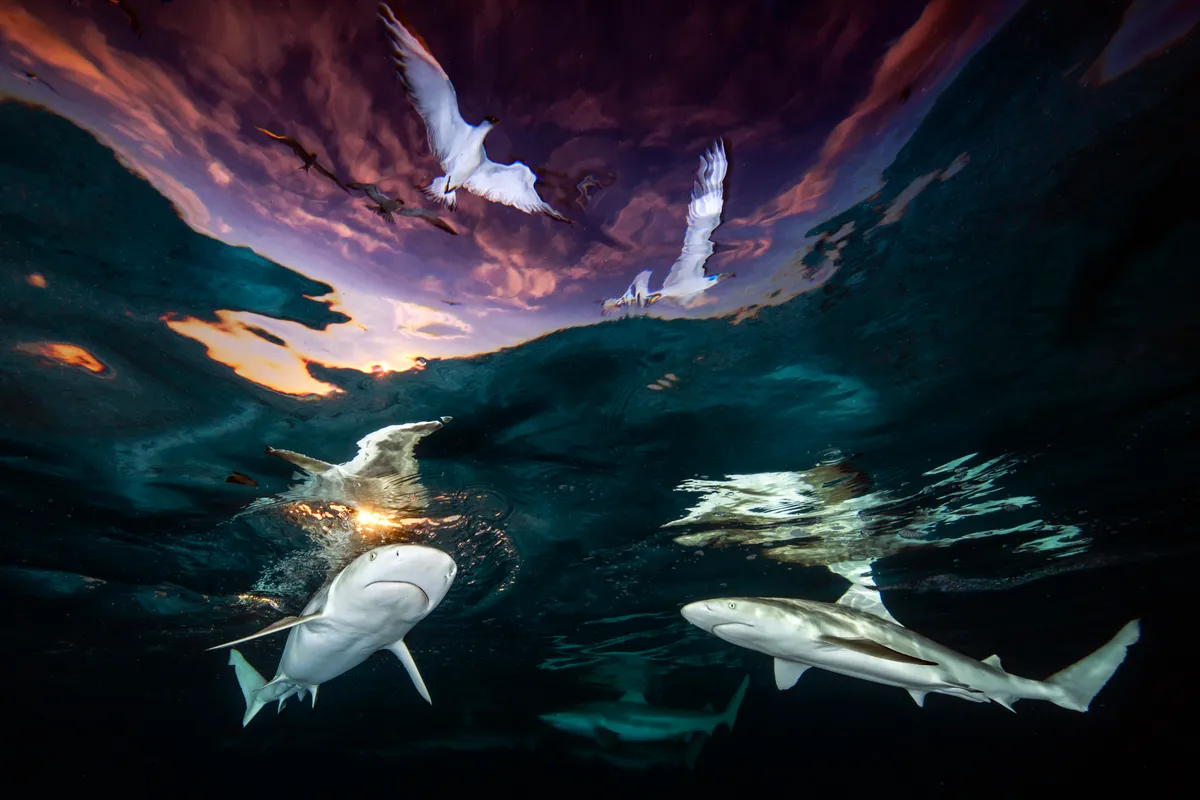
In French Polynesia there is strong legal protection for sharks, allowing them to thrive and balance the marine ecosystem. In August, 2020, I visited the island of Moorea, which was not only open to visitors but also happens to be my favorite place to photograph sharks.
During this trip, I spent several evenings in the shallows at sunset, hoping to capture something unique. Instead of focusing on split-level images that I am known for, I decided to try something different. I envisioned and aimed to capture the sharks underwater with the sunset seen through Snell's window.
It took many attempts, but on this particular evening the water was calm, the sharks came into a nice composition, and I got lucky with the birds as well. Since many shark species are threatened with extinction, it is my hope that images of these beautiful animals will help promote their conservation.
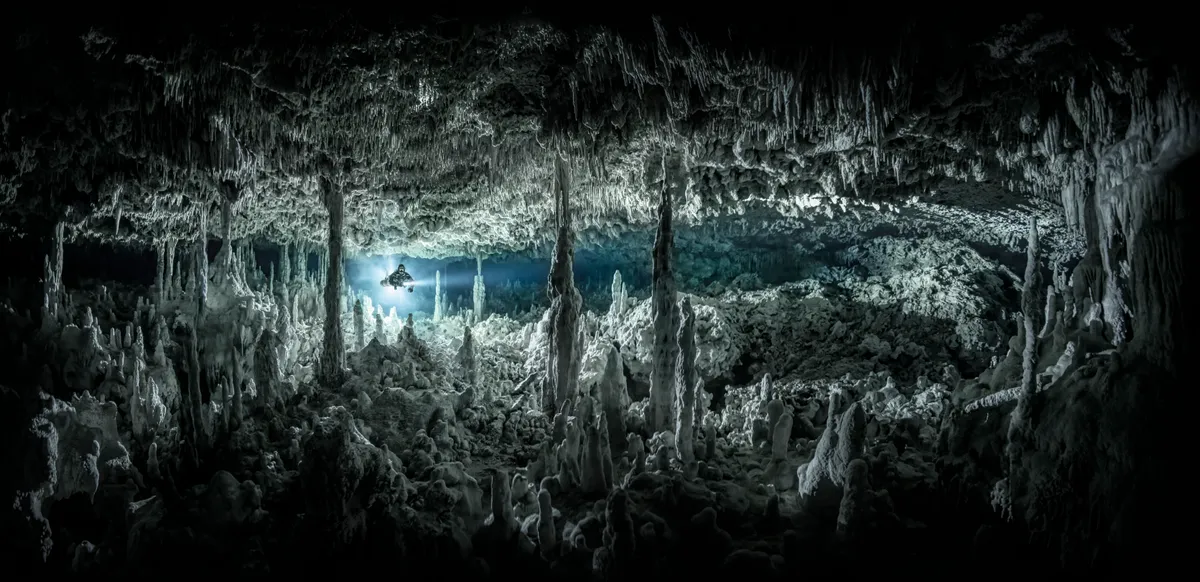
The riviera Maya in Mexico host the world’s largest underground river systems filled with clear water, never-ending tunnels and amazing halls with decoration that can compete with the best gothic cathedrals of the world. The challenge of capturing this beautiful hall in cenote Monkey Dust was not only the huge dimensions but the fact that is pitch black.
This photo is a x6 shot horizontal panorama stitching captured at 1/15 sec handheld at the usable limit of the camera ISO and diaphragm wide open to create an 86mpx panorama. My aim was to capture the scale, the tridimensionality of it, the richness of the formations and their incredible textures.
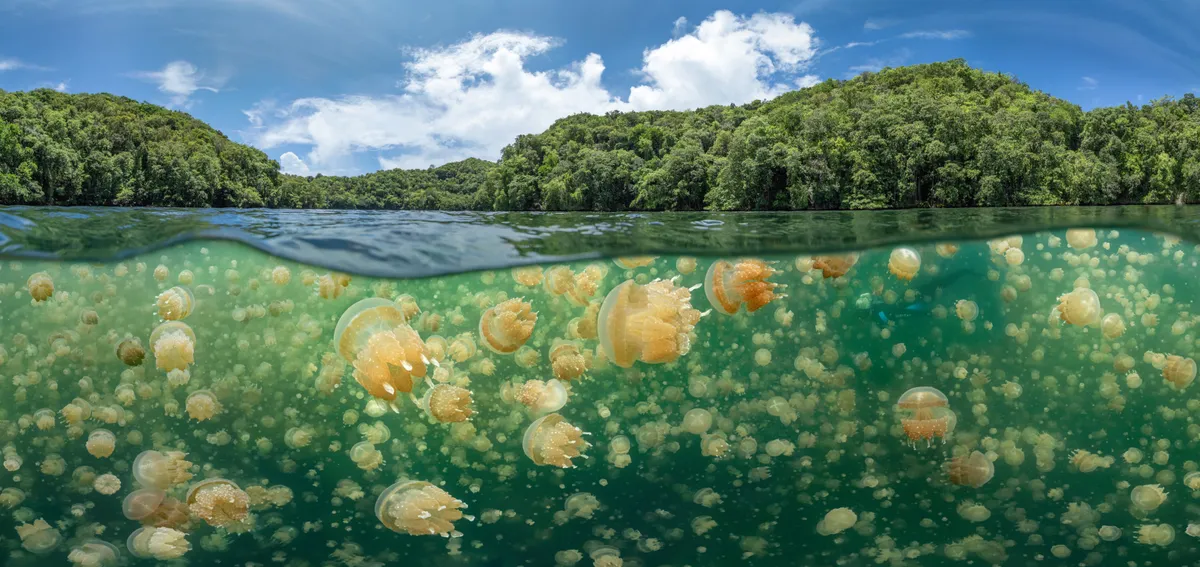
In March 2020, I flew to Palau for two weeks of diving. When I was there, the borders closed because of Covid-19, so I was able to fly back only after 3 months.
It was a good time. Dive sites where you could previously meet 50 people, I visited alone.
I have been to the jellyfish lake 4 times. Usually, a snorkeling session lasts 45 minutes due to the large number of tourists. But as I was alone, I could swim for 3-4 hours.
Before the first dive, the guide told me: swim to the center of the lake, there you will see jellyfish. In the center, I found only a dozen jellyfish and was upset. The second time I took a drone with me and quickly flew around the entire lake. 2 million jellyfish, about which I read in Wikipedia, gathered in a small group near the shore at the far end of the lake, which was about 500 meters away.
I took the camera and swam. I had to work with fins for 20 minutes until I ended up in real jellyfish soup. That's where I shot this panorama.
Macro category
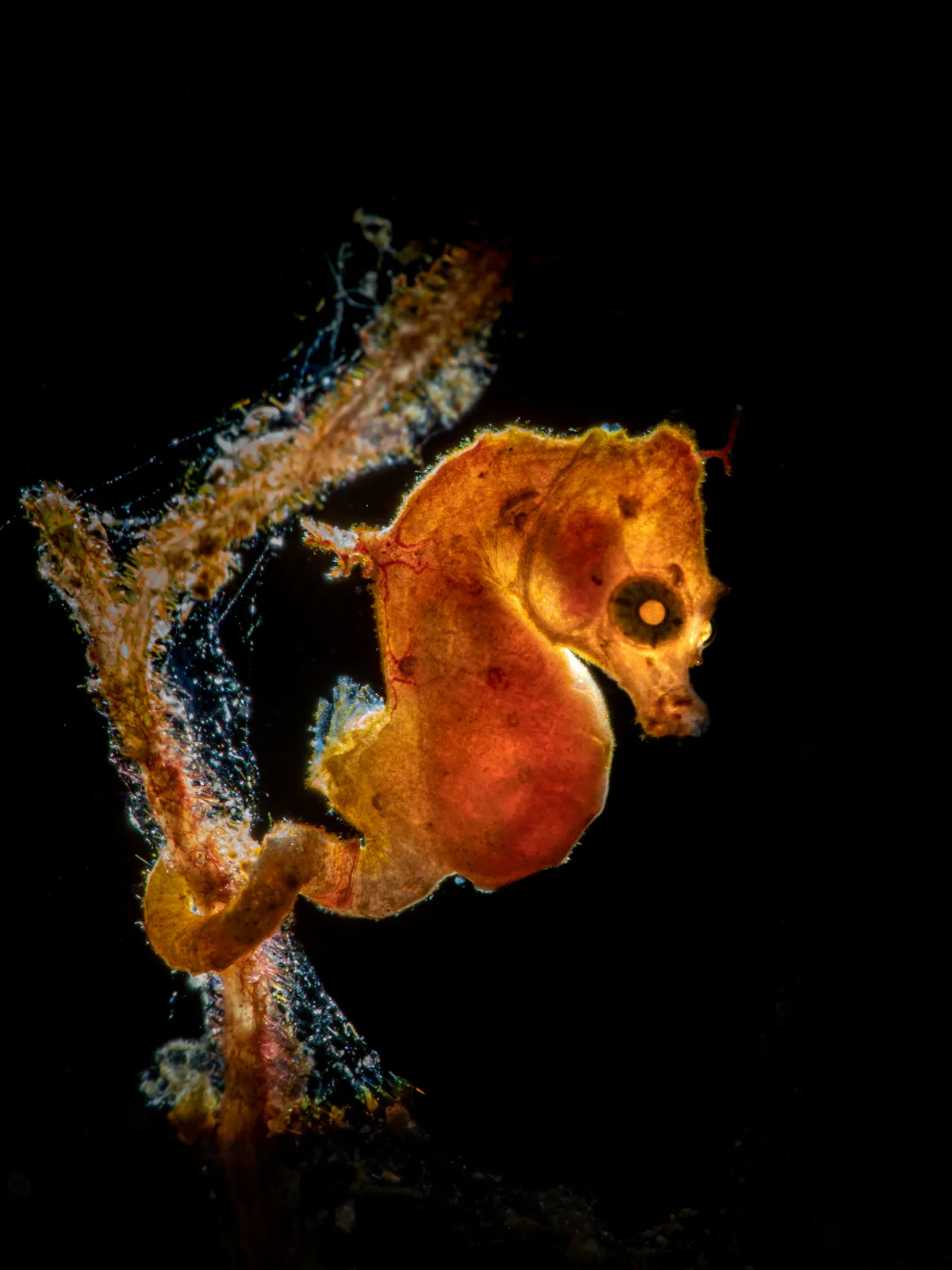
Pontohi pygmy seahorse (Hippocampus pontohi) is one of the smallest and most recently discovered seahorses. They usually live on reef walls and can be hard to find. We had found two during the morning dive so I decided to dedicate the afternoon to getting a backlit photo.
We were lucky to find this particular individual hanging out from the wall, allowing the use of a snoot to backlight it with the help of Rando, my dive guide. After setting up the camera and strobe we had to wait for it to get used to us and finally turn toward the camera for a brief moment.
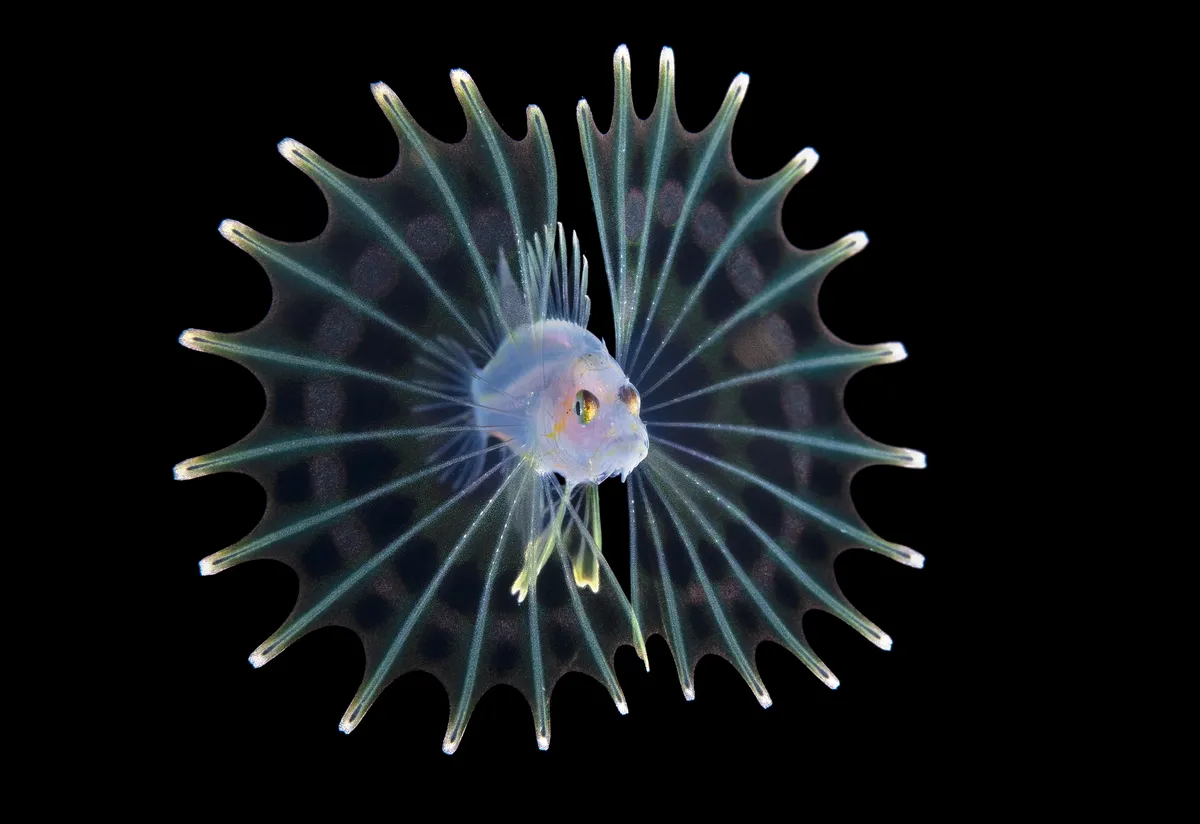
Drifting near the surface at night in over 700 feet of water, I came across this one inch larval Lionfish off the coast of Florida during a blackwater dive. In the Atlantic Ocean, Lionfish are an invasive species and, unfortunately, finding the pelagic larvae is an all too common occurrence during these dives.
This individual was exhibiting more beautiful coloration than usual and so I set out to try and capture its fins in full display. It's a challenging task, not only because they shun bright lights and usually try to flee, but also because they fully flare their fins in a defensive posture very sporadically and only for brief moments of time. I was very fortunate to be able to capture this particular individual in all its glory.
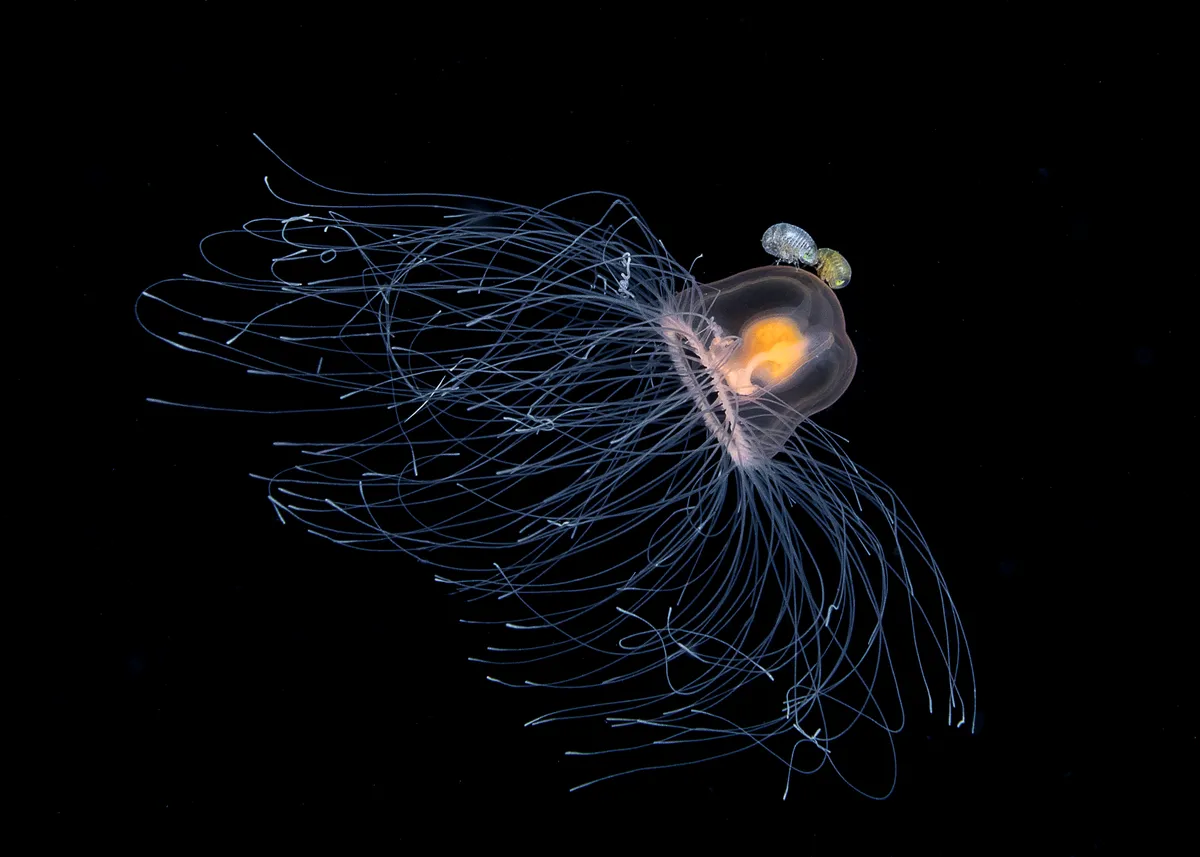
When I dived at night and saw this jellyfish it looked very cute. It looked like an alien creature had appeared in front of me. It has a lot of tentacles so sometimes looks very messy. But I really wanted to take a picture of his tentacles that are vertical, so I waited for a while and finally took the picture, but when I replayed the picture, I found two bugs on it's body. They were like taking a spaceship to go traveling in space.
Wrecks category
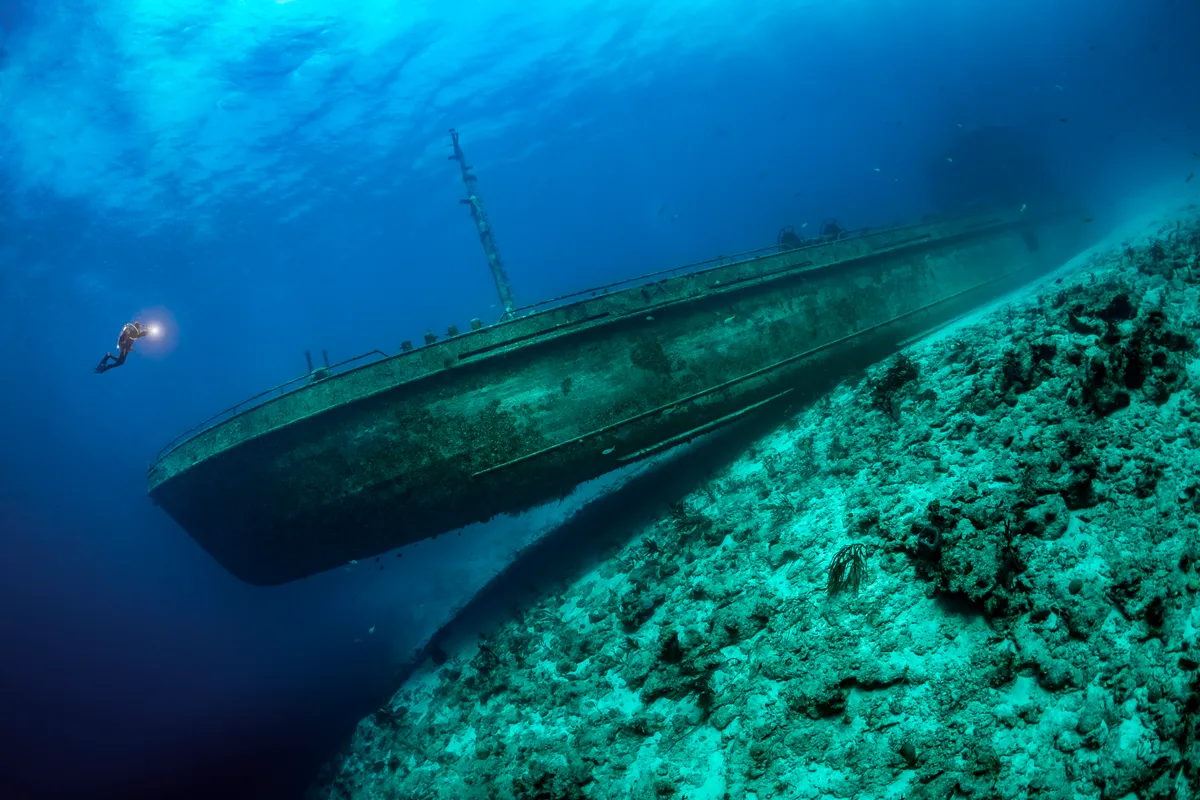
Due to bad weather at Tiger Beach and in Bimini we had to look for shelter near Nassau in the Bahamas and do some regular dives. This wreck was totally new to me and a big surprise when we descended as the bow is hanging almost completely over a sandy overhang.
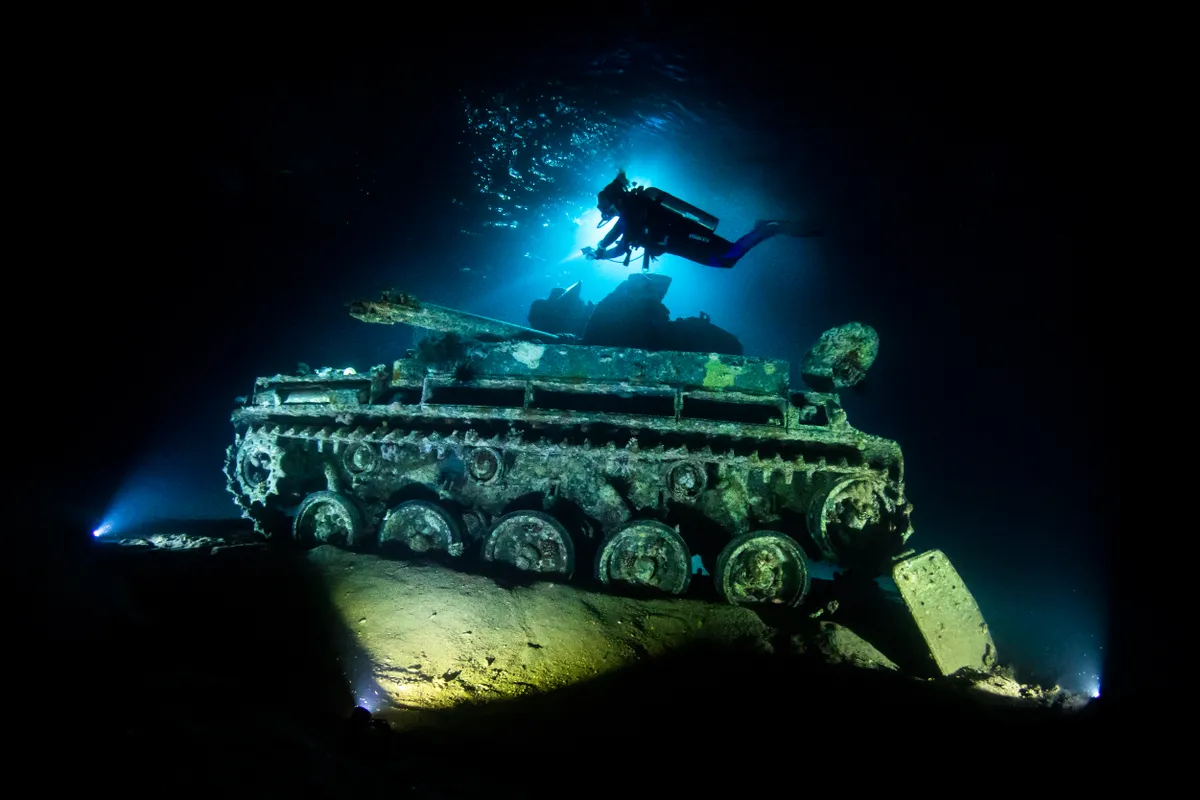
It was late in the day and the sun was setting over the arid landscape of Jordan’s southern most city, Aqaba. Myself and a group of underwater photographers were all waiting eagerly for night time to come so that we could enter the water and begin to explore the huge array of military hardware which has been purposely sunk for divers to enjoy.
We decided to use a combination of powerful off-camera lights to ‘spot light’ the tank (M42 duster) and back light a diver, which helped eliminate any distracting elements in the background. Creating this image was a team effort andI I have to say a huge thank you to the entire Diverse Divers team for making it happen.
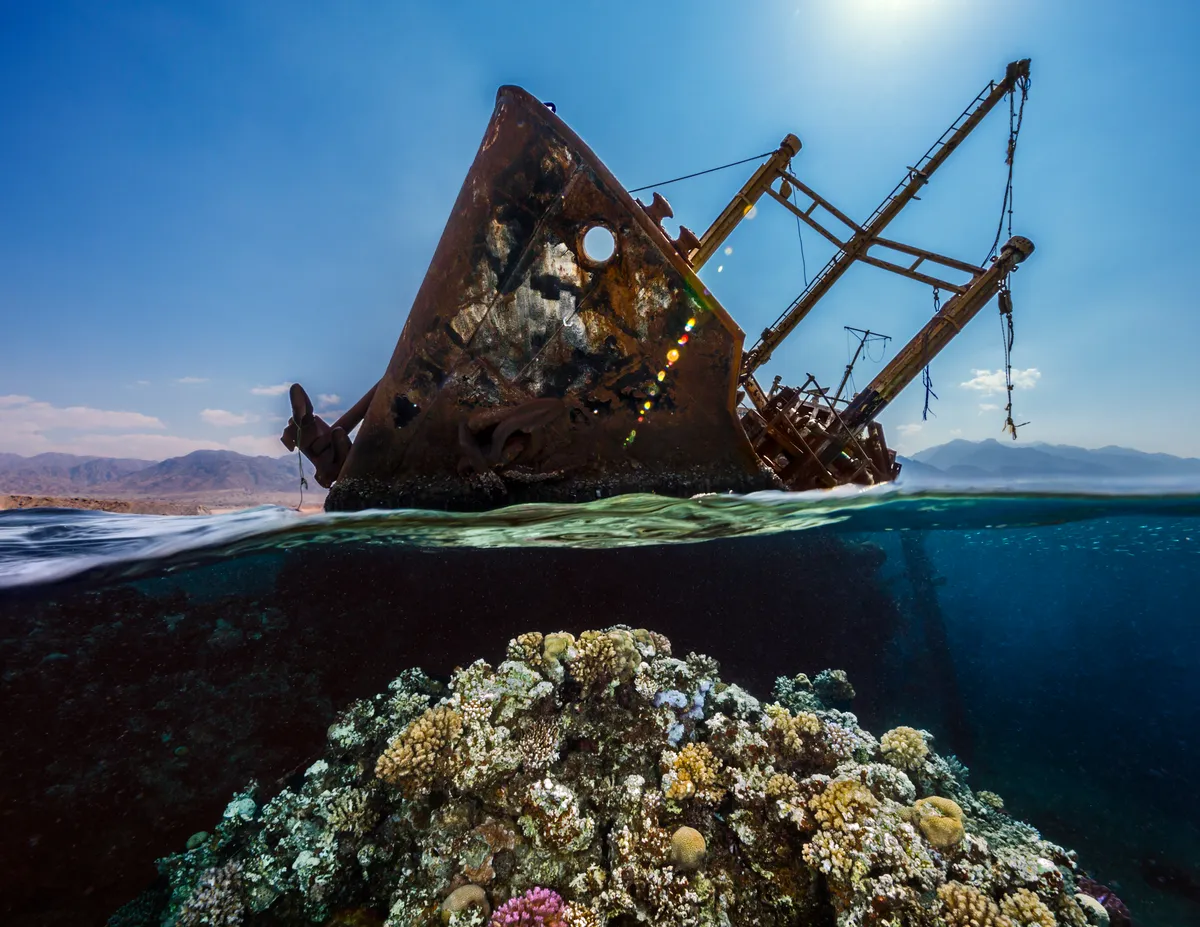
This split shot of the Georgios shipwreck was taken in Neom, Saudi Arabia along the Gulf of Aqaba in the Red Sea. In 1978, this large cargo ship originally from England became stranded on a shallow coral reef at night and then suffered from a large fire. Now serving as an artificial reef for many marine organisms, this wreck sits halfway out of the water on the bow side and in roughly 80 feet of water on the stern side.
Some locals refer to this site as the "Saudi Titanic." To achieve this photo, I used a very small aperture, an extremely wide rectilinear lens at 12mm, a lower ISO, and strobes to light the coral underwater.
Behaviour category
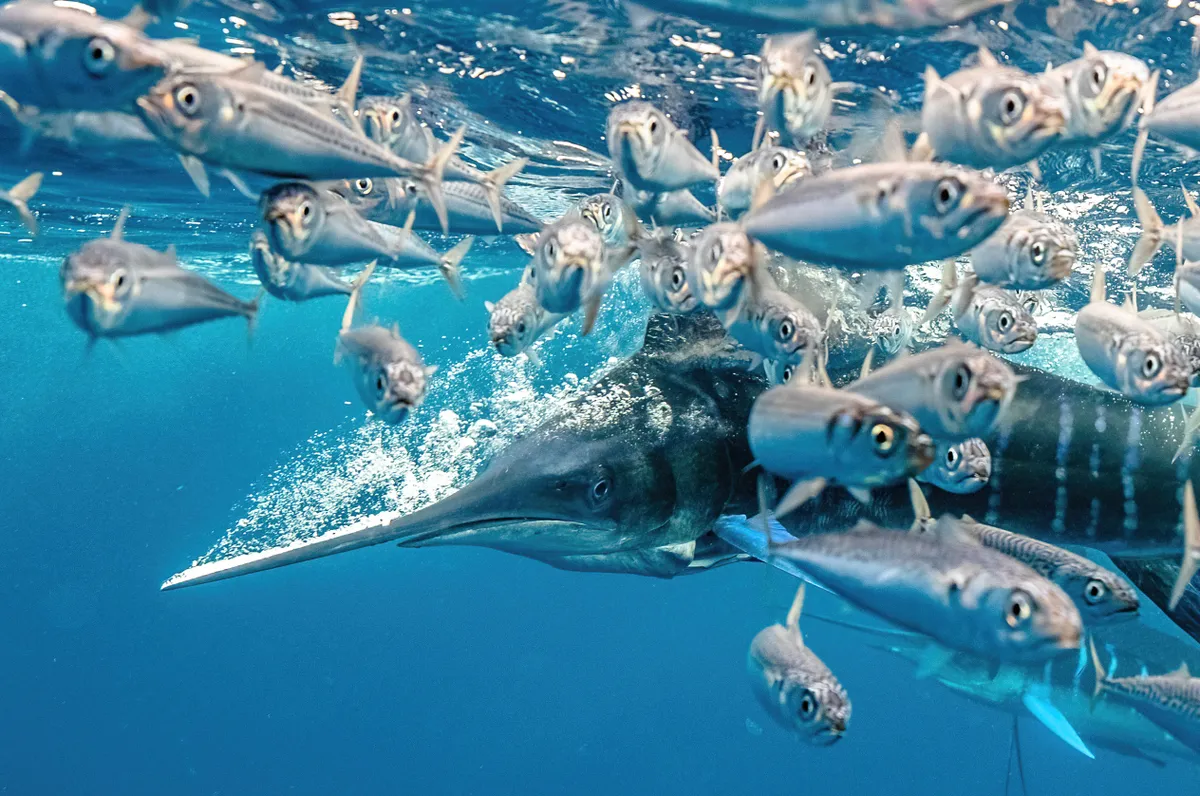
This is a terrifying scene for the small fish, fleeing for their lives as a striped marlin hunts them. The slightest mistake means life or death. There are often birds hunting from above and sometimes a dozen other marlin and sea lions attacking from all sides. Marlin are one of the fastest fish in the sea, a terrifying predator for a small fish in the great blue desert.
I went to Mexico to document these feeding frenzies but was not expecting such a fast paced hunt, almost too fast for my brain to process. For a brief moment, this scene unfolded before me and I had to rely on all my instincts and practice underwater to take this photo. I used natural light and stayed on the periphery of the bait-ball so as to try and minimize disturbance. Watching wild animals hunt is one of the greatest spectacles in nature.
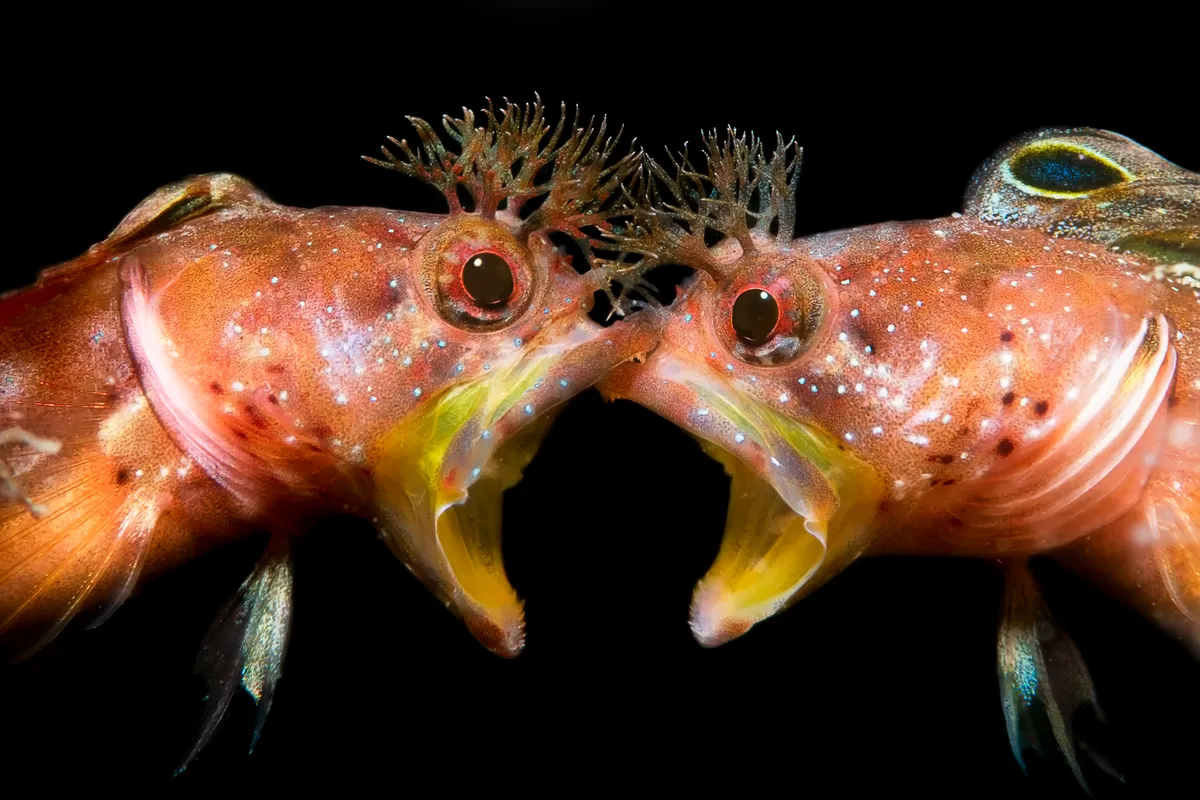
This is a picture of blenny in a fight. It is a species of chaenopsid blenny found around Japan and South Korea. Its most distinctive feature is its very cool hairstyle, which is often referred to as Punk blenny or Mohican blenny. In fact, this kind of blenny fight scene is very rare because they usually just stay in their lair and don't interact with other individuals. But during the breeding season, if an area is too densely populated, the blenny will engage in fierce fights for a mate, and these fights are often quickly settled.
Blenny is one of my favorite projects. From getting information to the long waiting and searching, it took me about three years intermittently to shoot this scene. I would like to thank my Japanese friends who have helped me in this process. At the same time, I am very honored to share this charming moment.
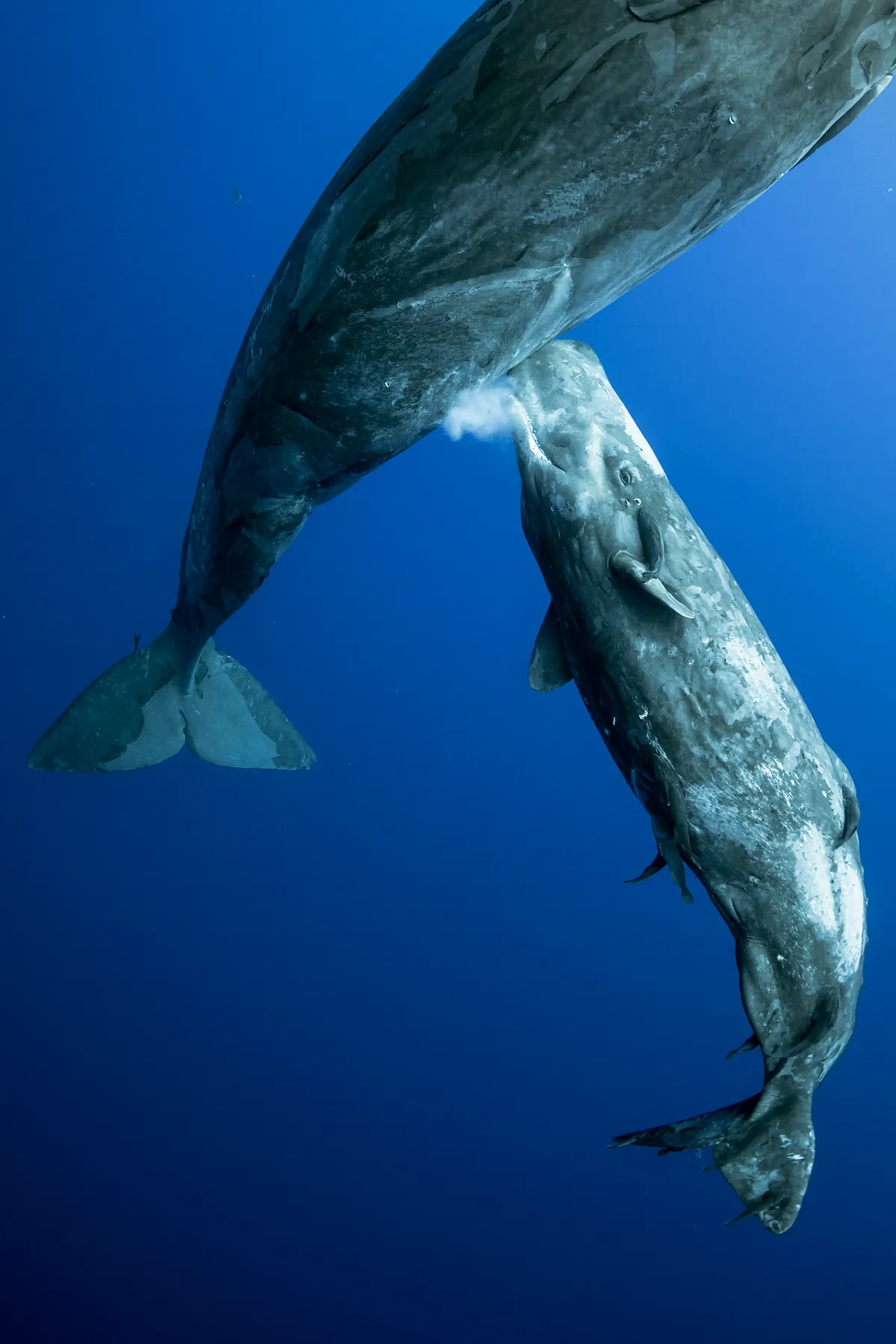
On this day a family of 13 sperm whales allowed me to stay with them the whole day. It is a big honour for this human to be with whales in their habitat in the ocean. These whales probably remember whaling years ago but they forgive us. At the end of the day one mother starts to feed her calf just meters from me. I froze and didn't move. It was incredible to see such a private moment.
Portrait category
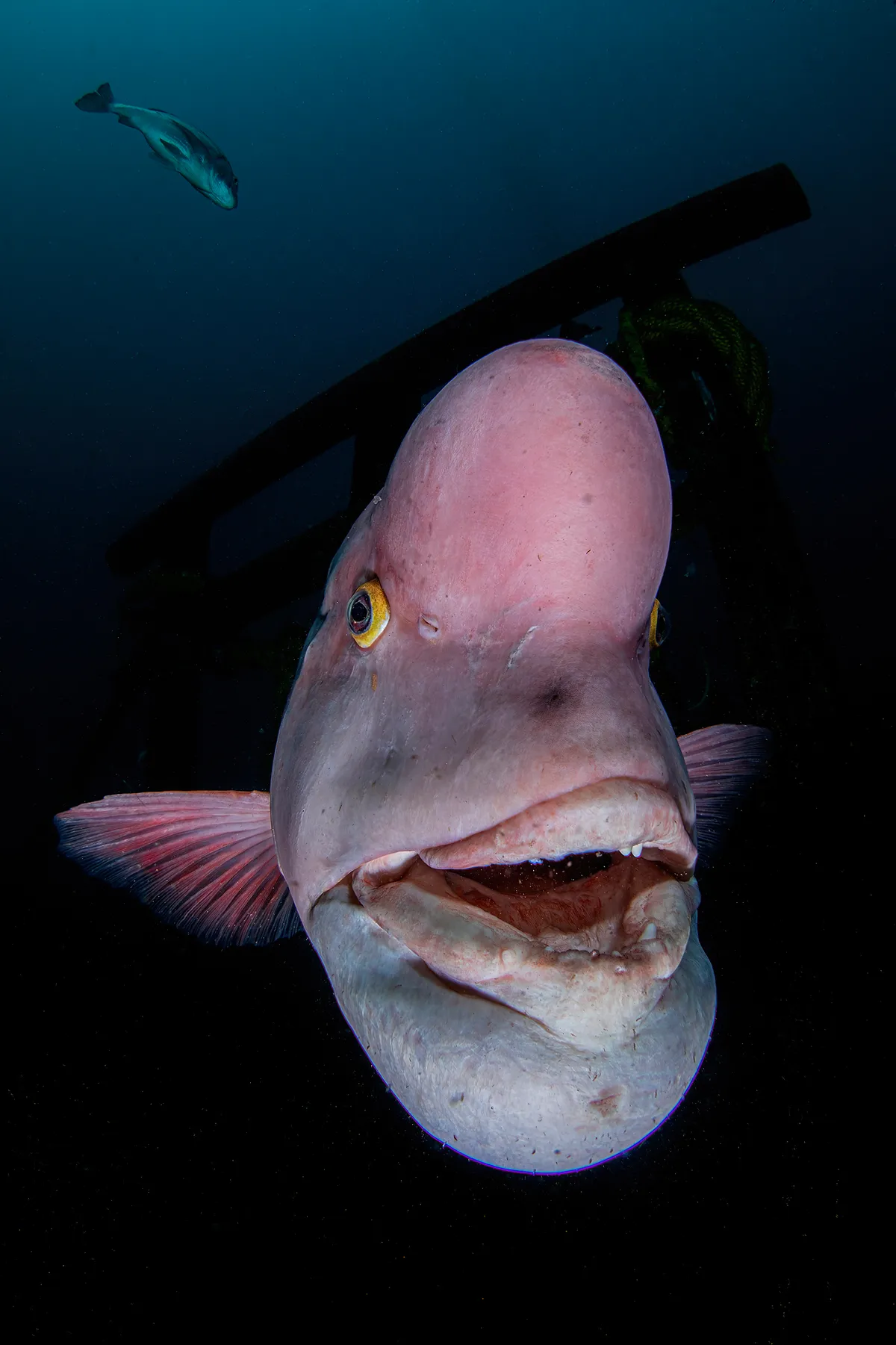
As the Asian sheepshead wrasse grows older, it changes sex from female to male and at the same time it develops a large lump on its head. I thought about the lighting and composition so that the image of the bump and the powerful face could be conveyed, and challenged many times. He lives in a shrine under the water and looks just like a guardian deity.
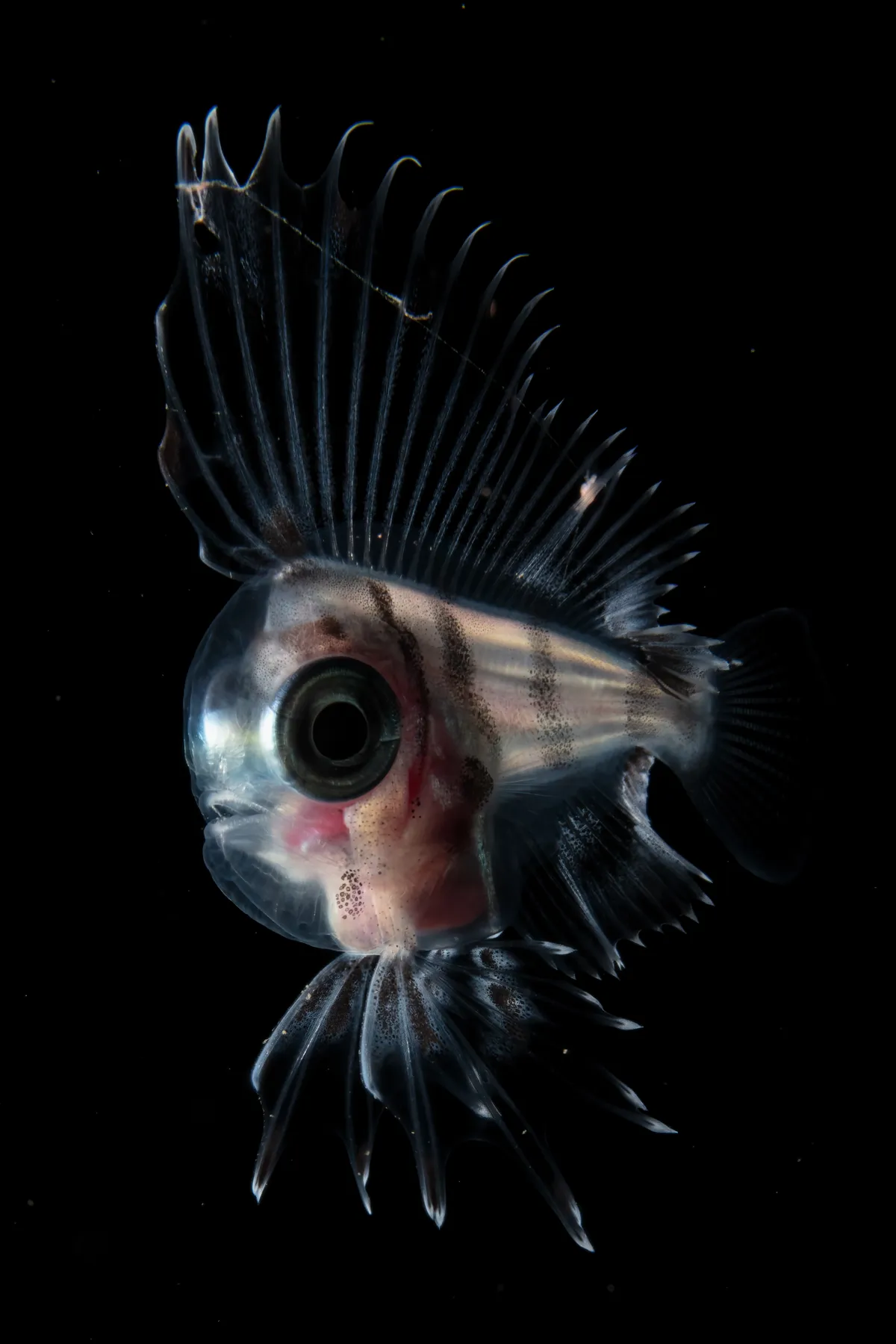
Japanese manefish is not a fish that can be found by looking for it. It can only be encountered by diving when a perfect tide brings them close to shore. I have dived for 20 years and I took this picture when we met for the first time. Japanese manefish juveniles have mirror-like skin and have a glassy, crystal clear body, so I chose to light it from the back to reveal these characteristics.
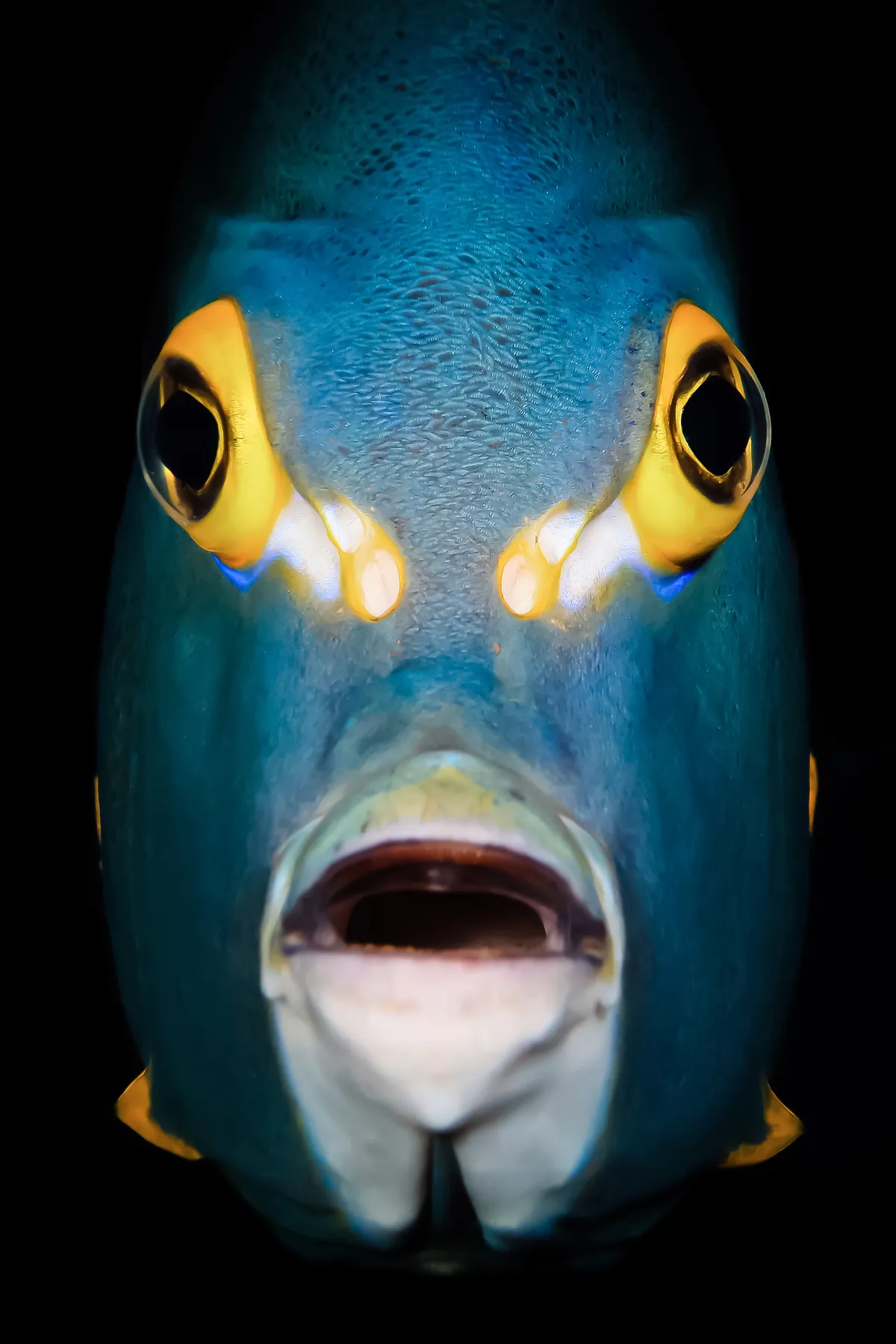
I took this portrait of a gorgeous French angelfish whilst scuba diving at the legendary Salt Pier in Bonaire in the Caribbean. Luckily for me, two key elements combined together so that I could snap this intimate portrait of one of my favourite fish - firstly, my subject was somewhat familiar with divers already and not afraid to face the camera, and secondly, I was able to exploit the shadows under the pier itself to create a dark background which helped highlight the exceptional beauty of this particular fish.
Black & White category
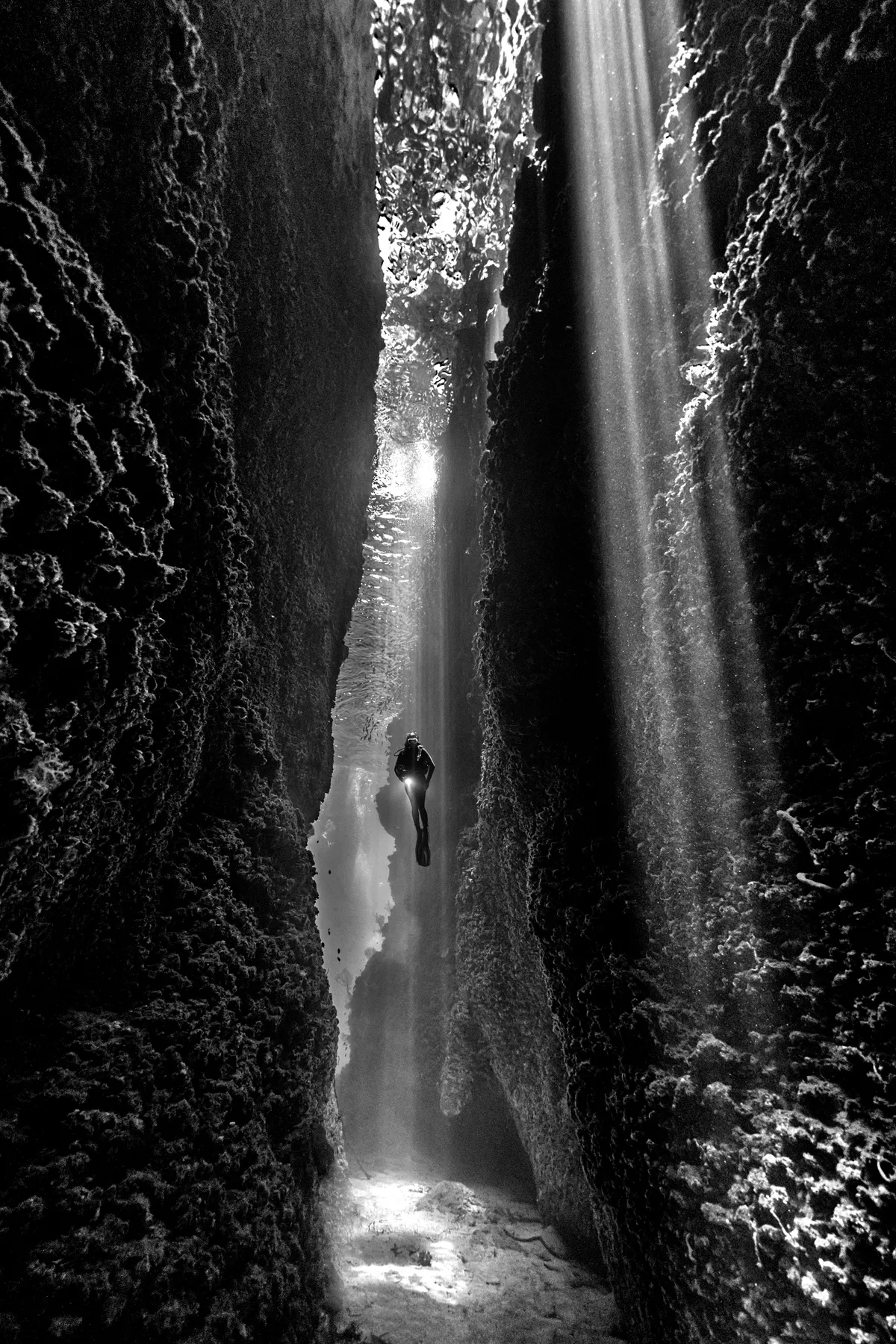
This photograph was taken at Leru Cut in the Solomon Islands. I was lucky enough to have won a 10-day trip on the Solomons PNG Master liveaboard and was very excited to have the opportunity to visit this site again. Having dived these waters on two previous occasions I knew what to expect. However, I needed an elegant model as an essential element for this composition and my immediate companions could not be classified in any way as elegant!
Fortunately, there was another photographer in my dingy group whose beautiful model wife was the perfect subject. Somewhat cheekily I managed to capture a few shots of her as she posed for her husband!
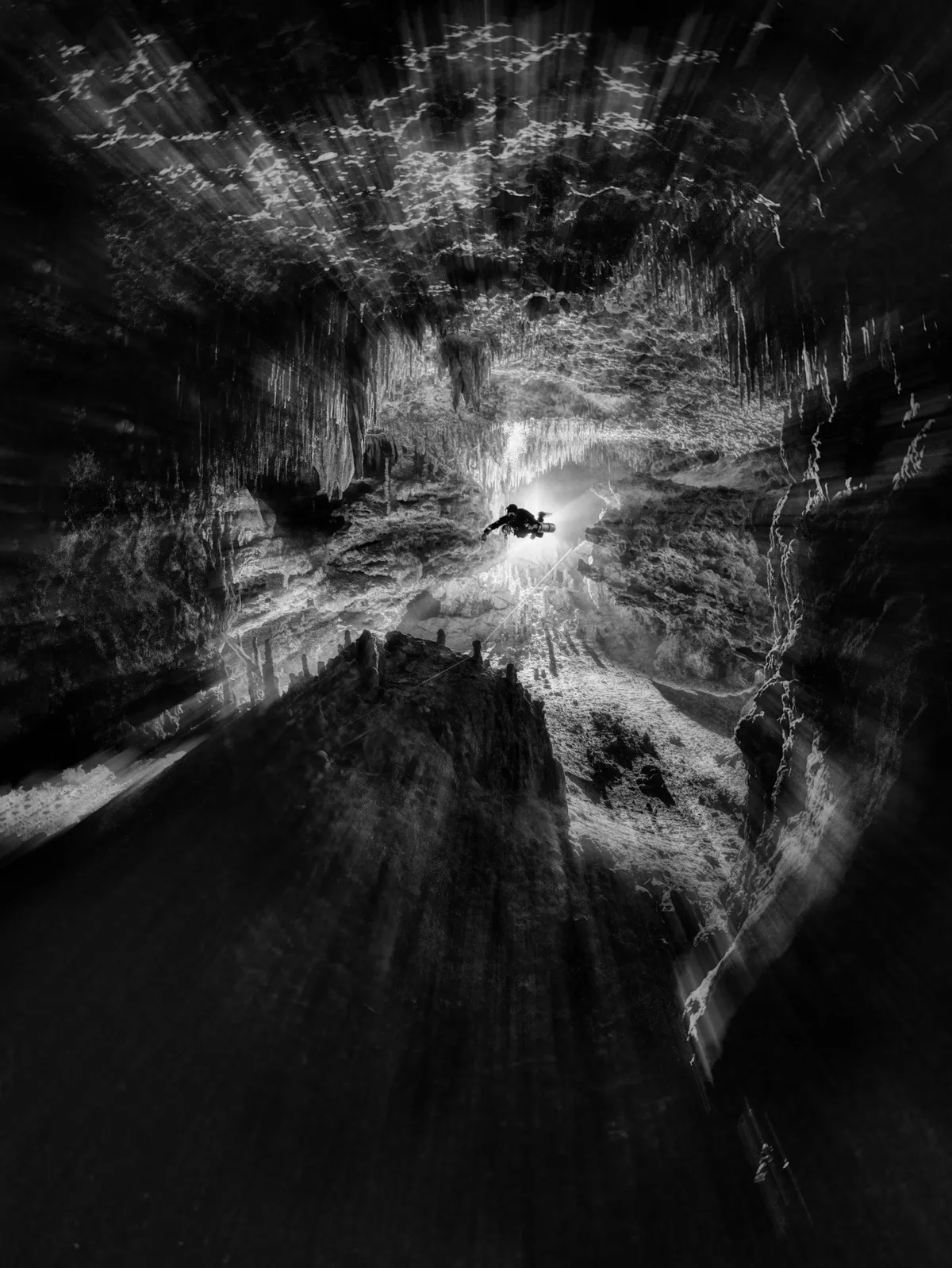
Imagine yourself in an underwater cave in Mexico, hours away from the exit to surface, diving through a never ending labyrinth covered with prehistoric formations, seeing charcoal in the ground from the fires of an ancient culture, finding bones of animal species extinct 8000 years ago, and everything around you is preserved as it was back in the time those caves flooded. It's a visceral feeling of going back in time to a different age.
This image is trying to capture that. The rugged texture of those prehistoric overhead environments with pristine formations framing the diver in darkness. The depth of the never-ending tunnels and the feeling of the travel in time given by the zooming movement into the light and model. And the processing in black and white to simplify the image. A claustrophobic feeling for some and of discovery and adventure for others.
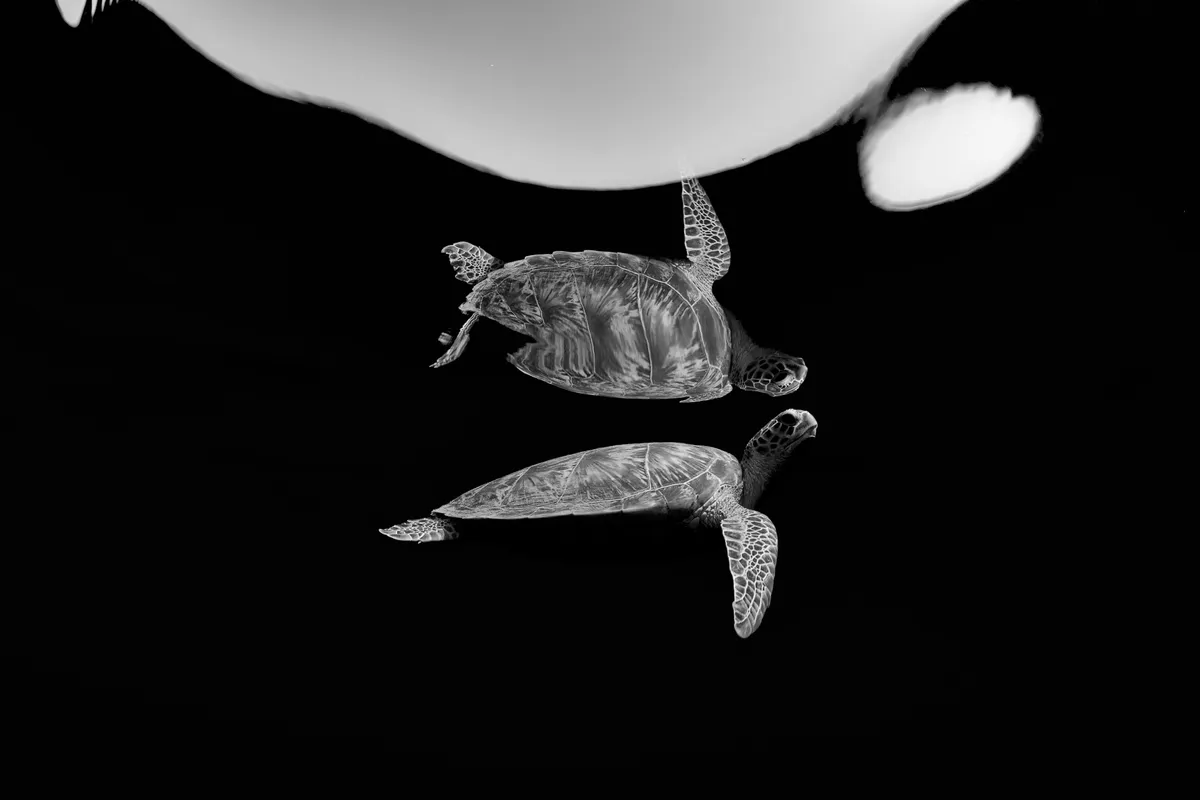
During the long months of the pandemic I had to revise, like everyone else, my usual way of life and had to replace the usual diving with snorkeling and this activity surprisingly gave me new time and space, interesting perspectives and different points of view. It gave birth to my life in a time of shadows. This summer, snorkeling very early in the morning in Marsa Egla, I often met the smaller and friendly hawksbill turtle of the bay. Enchanted by its elegant movements, I watched it for hours eating and breathing.
I noticed that particular conditions of light and sea made perfect the reflection of its being on the surface. For days I have been waiting patiently for that favorable situation and that its figure could be captured in a photo as I imagined it: a perfect moment of freeze its geometries in the light reflected on the surface.
Compact category
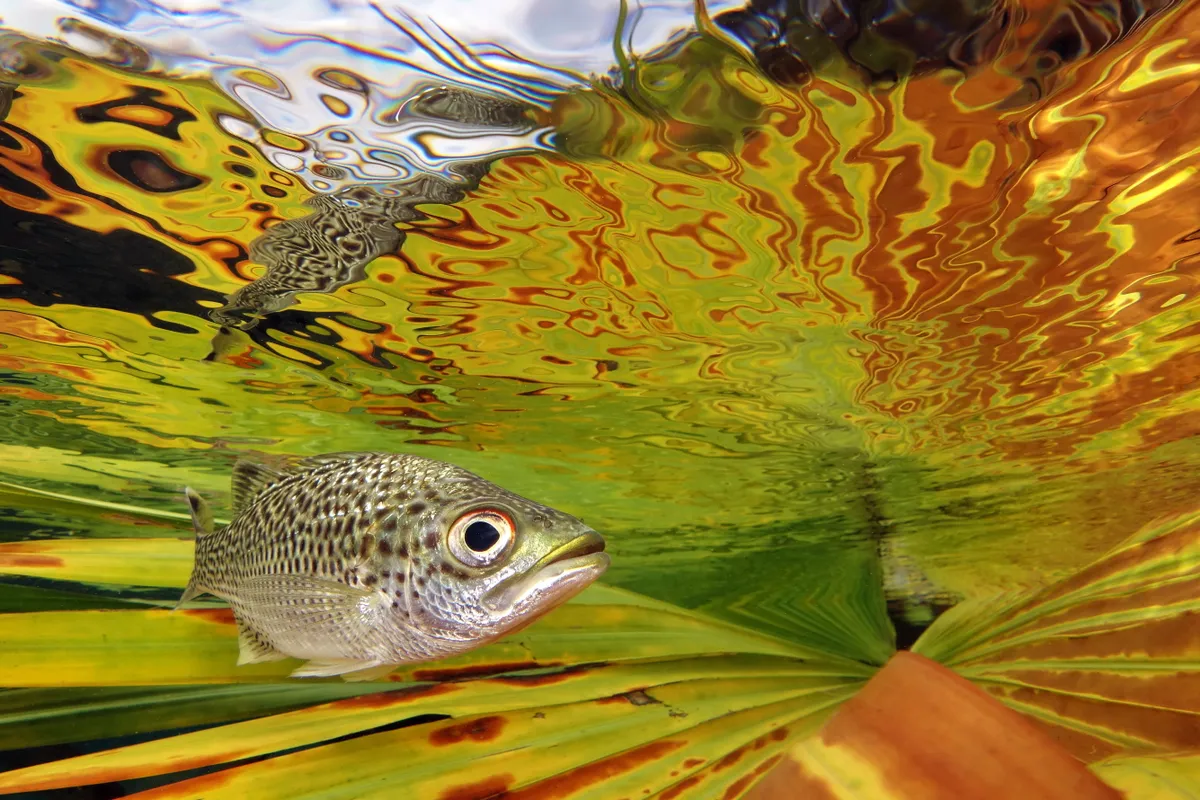
I used to go fishing in the river to take some shots a few days after big rains which make the riverbed go higher and make some big floods. The current is strong but still practicable for freediving with dislodged plants, leaves and branches. They bring a lot of colors which showcase this plain New Caledonian carp which are common in our rivers.

When I was underwater with this hairy panda goby, he was very shy so it took a long time for it to be comfortable before it popped it's head out. While waiting, I set up my coloured torches and align them to illuminate the coral, but not the goby. Then to produce a sharp picture of the goby I had to use another snoot with white light, so that it is recorded correctly and surrounded by all the colours.
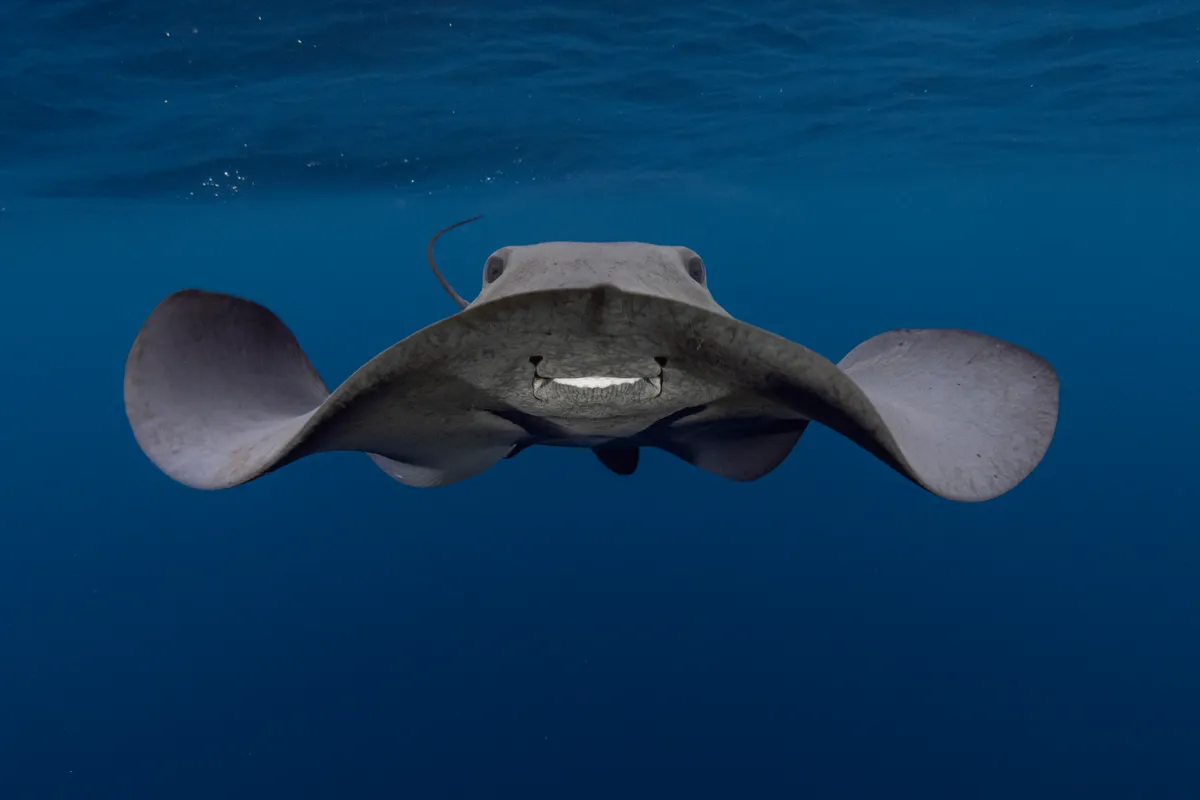
This image was taken in summer, offshore from Bermeo, while doing a shark dive. Being surrounded by three blue sharks, this pelagic ray appeared to check the bait. It was a very rare encounter, this animal was not been sighted before in this waters, and I too had never seen this animal before. It was going in and out from the bait, so I tried to get close to it calmly, then it come right to my dome and I took the photo.
Up & Coming category

As this shot was taken during cave training, we had a pretty intricate plan in place, which is not usually how I run caves shoots. However, the plan failed miserably as the cave student, Max, had multiple equipment failures before even making it past the cavern zone. Plans are important, but when they fail you need to adapt quickly and deal with a new situation. After fixing all the issues on the surface and changing our plan to accommodate our now fairly depleted gas supplies, we descended again.
I swam ahead and waited just beyond the beginning of the permanent mainline watching the team swim towards me, followed closely by the lighting assistants creating those beautiful halo effects. Suddenly everything just lined up perfectly, so I pressed the shutter just as Max turned to tie into the mainline.
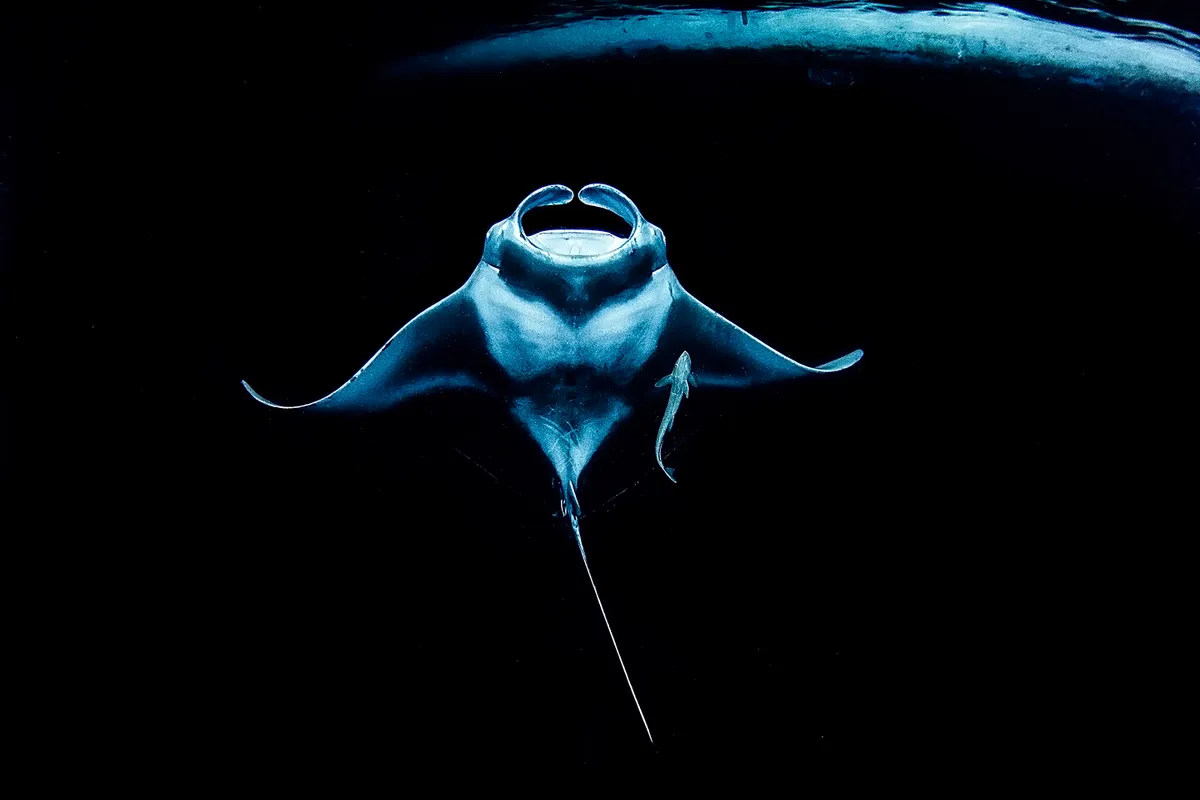
As we were mooring the safari boat in the lagoon at night, manta rays came behind the boat to eat the plankton that gathered in the light of the boat so I put on my snorkel and fins and went into the sea with my camera.
This manta ray, which preys on plankton, repeatedly flipped in front of me and went deep into the water. The appearance of the giant dancing in front of me was a masterpiece. Watching the situation up close, I was absorbed in releasing the shutter. This photo was taken aiming at the manta ray rising from the depths toward the light on the surface of the water.
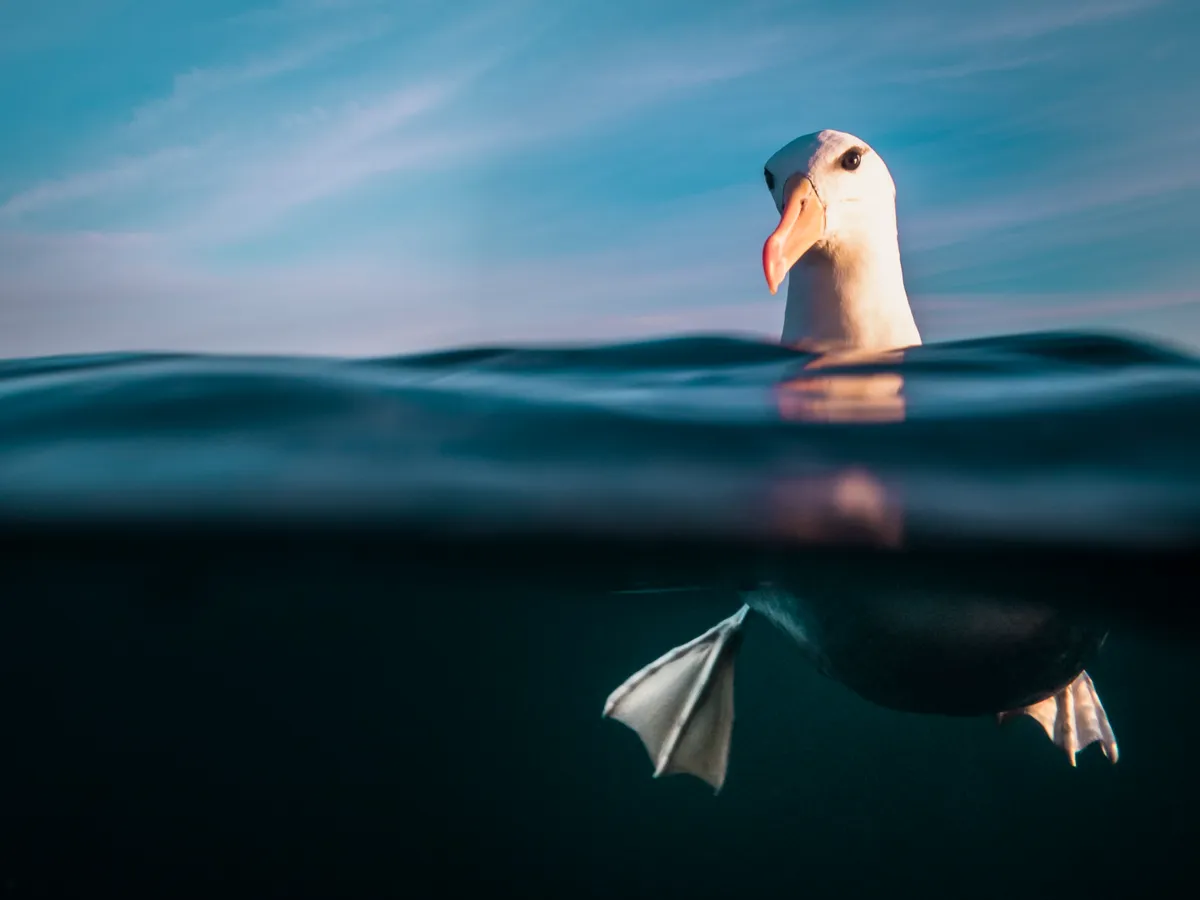
Whenever I see an albatross I get excited! Their sheer size and beautiful features make them a joy to photograph. I have been working on a series of split shots of the various species of albatross that visit Tasmanian waters for a few years now.
Getting good eye contact as well as good feet symmetry is a challenge as they are generally quite shy birds. I use a very simple inexpensive compact camera and do not use a wide angle dome or wet lens when taking these photos. The small 6cm flat port on my housing may be small but works a treat in calm conditions. Getting the exposure settings right is the important part because the albatross' feathers are so brilliantly white, and yet it can be reasonably dark underwater.
British Waters Wide Angle category
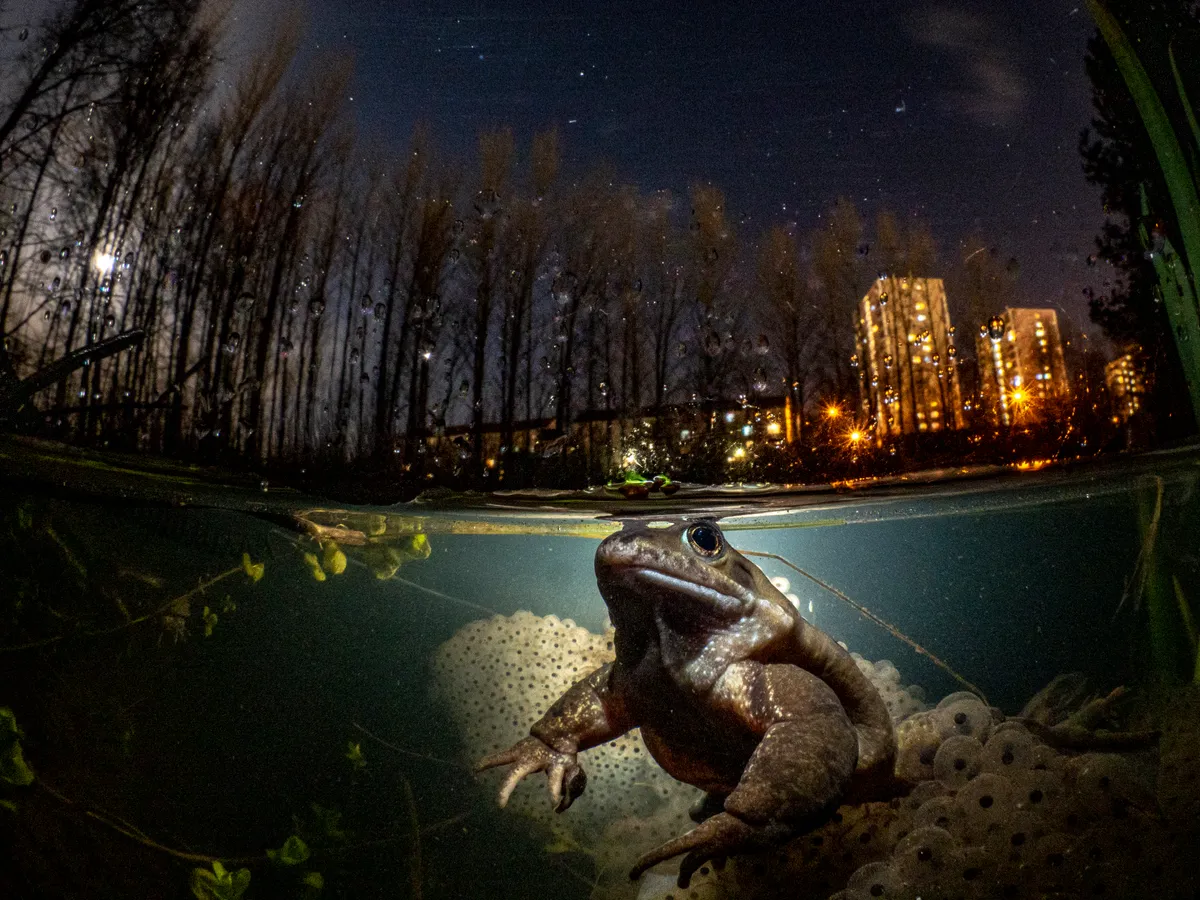
Malls Mire - small woodland in Glasgow, between a housing estate, supermarket and factory - is an unlikely haven for wildlife. As winter thaws, for a few nights each year one of it's small muddy ponds comes alive with Common Frogs. I first photographed them here in 2018 and since that day I've had this image in my head. It took another two years before I captured the little wonders that stir in the cold nights while the city sleeps.
Using a temperamental remote shutter while combining long-exposure, backlighting, close-focus wide angle and split photography meant I had to abandon any frustrations and try (and inevitably fail) for the hundredth time to get it right. This final shot is a culmination 25 hours over 4 nights of lying in darkness, covered in mud, waiting on natures unpredictable elements to align. Time well spent? Absolutely.
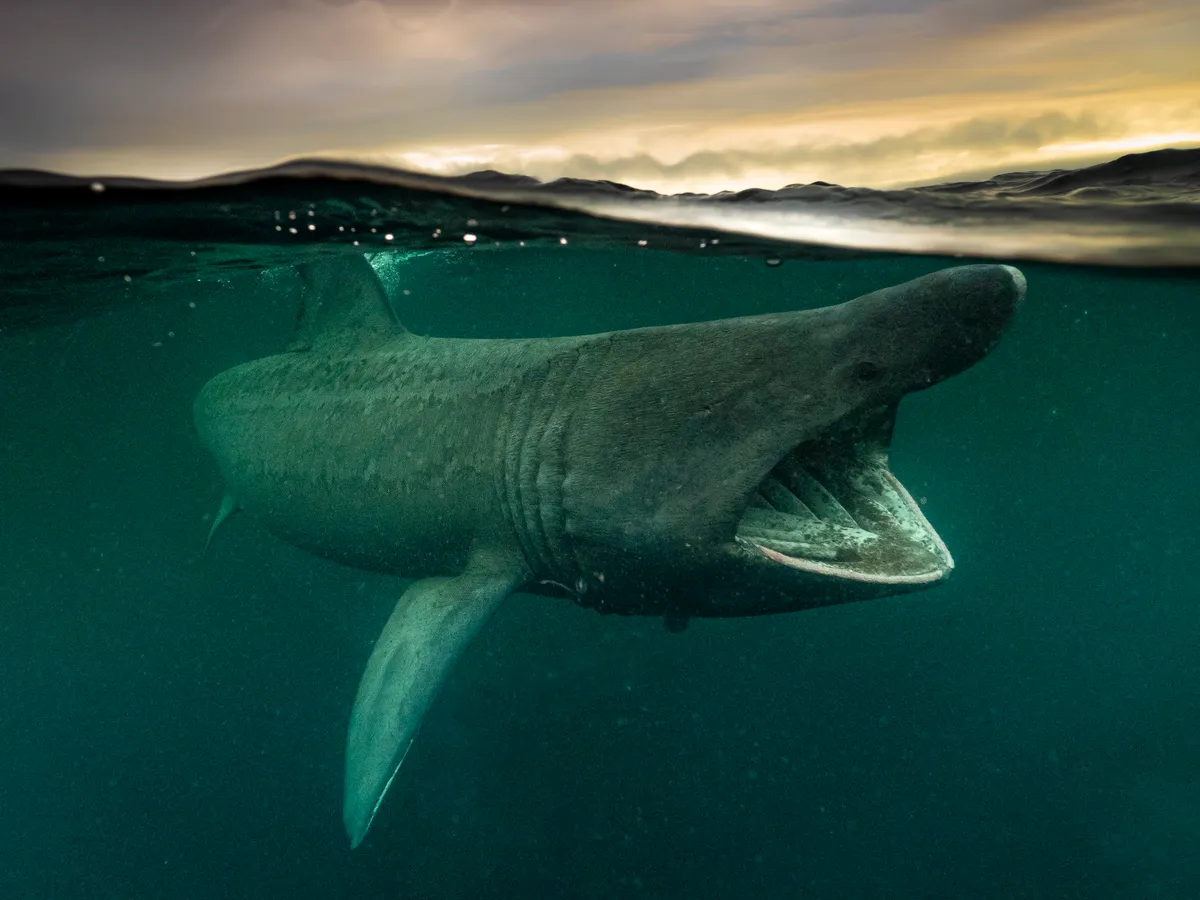
It’s the microscopic plankton which draws the massive basking shark up the west coast of Britain and into the narrow channel between the Isles of Coll and Tiree. While their migration is predictable, to share the water with them still requires that element of luck and to spend a late summer evening with them (in 2020 of all years) was a dream.
I’ve photographed basking sharks before and never managed that classic ‘head-on’ shot, so decided to try for something completely different instead. With challenging lighting conditions and plankton rich waters, I wasn’t sure if it could be done but after two years of planning, an experimental 19-inch dome (frame made by my brother - thanks Paul), trial and error with lenses and ND filters, and of course - the arrival of Sharks - I finally had the chance to find out.
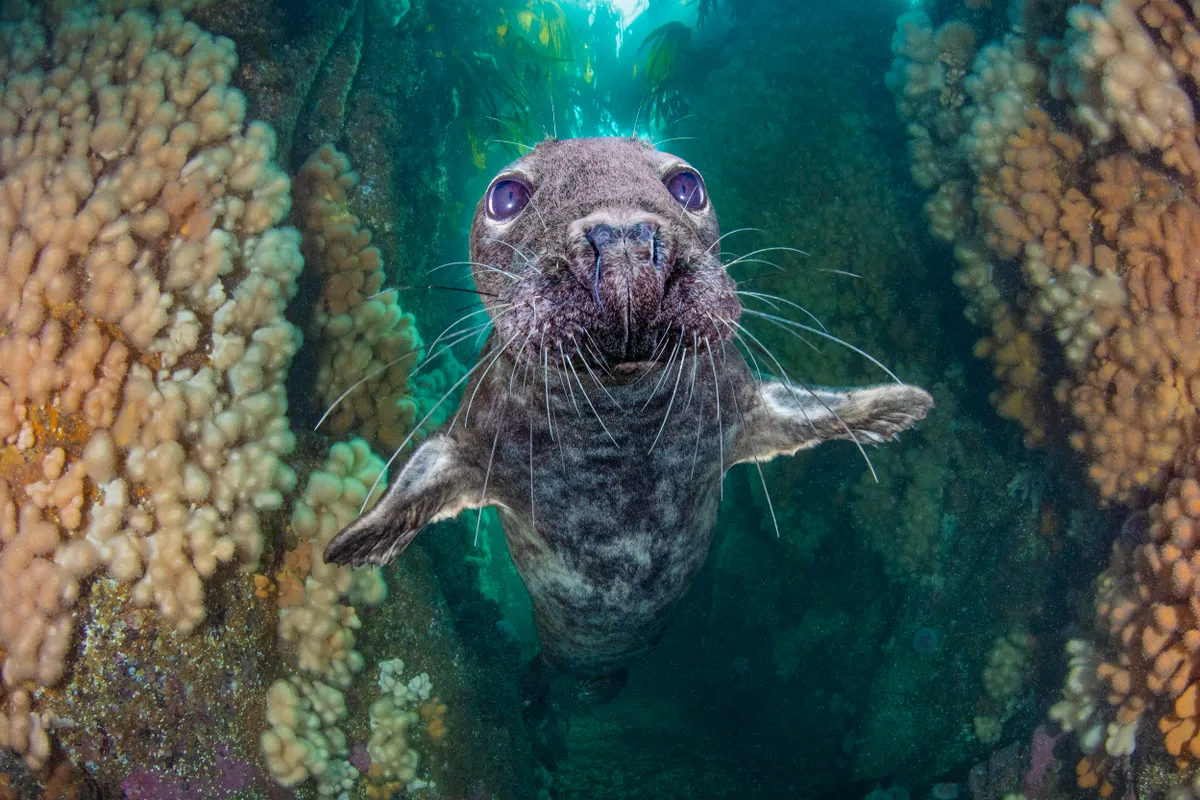
Grey seals are wonderful to photograph but I particularly like this shot because of the background. My buddy showed me this pretty gully full of dead man's fingers and light coming down through kelp. I waited there for a little while, hoping a seal would turn up. In the end I only had one quick pass from one shy seal, but I was able to take this pleasing portrait.
British Waters Macro category
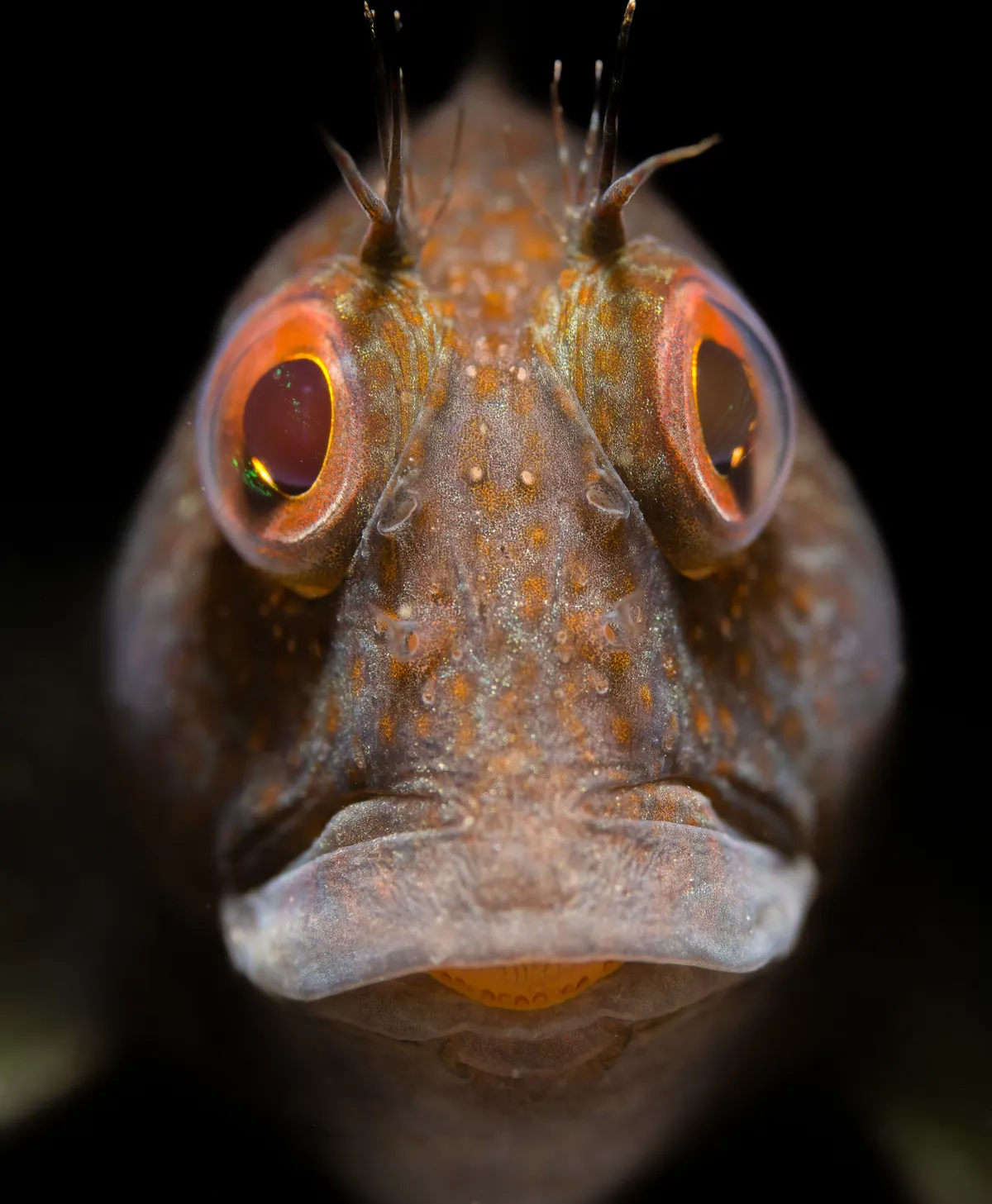
The variable blenny (Parablennius pilicornis) is a relatively new arrival to UK coastal waters, with its origins from more southerly waters (it has been recorded throughout the Mediterranean Sea). This species may appear in a number of different colour forms. The current image is of a male and was taken in Plymouth Sound, July 2020. This particular blenny was standing out proud on a reef ledge, making it an ideal subject. The image was captured using snooted lighting to emphasise only the face of the blenny, with the snooted light being positioned from above the head enhancing the facial features.

A beautiful summer morning in mid-July, we left the beach and swam though beautiful clumps of bootlace weed in the high tide. Looking closer, we could see snails, shells, anemones and stalked jellyfish making their temporary homes among the weeks. Very peaceful moments.
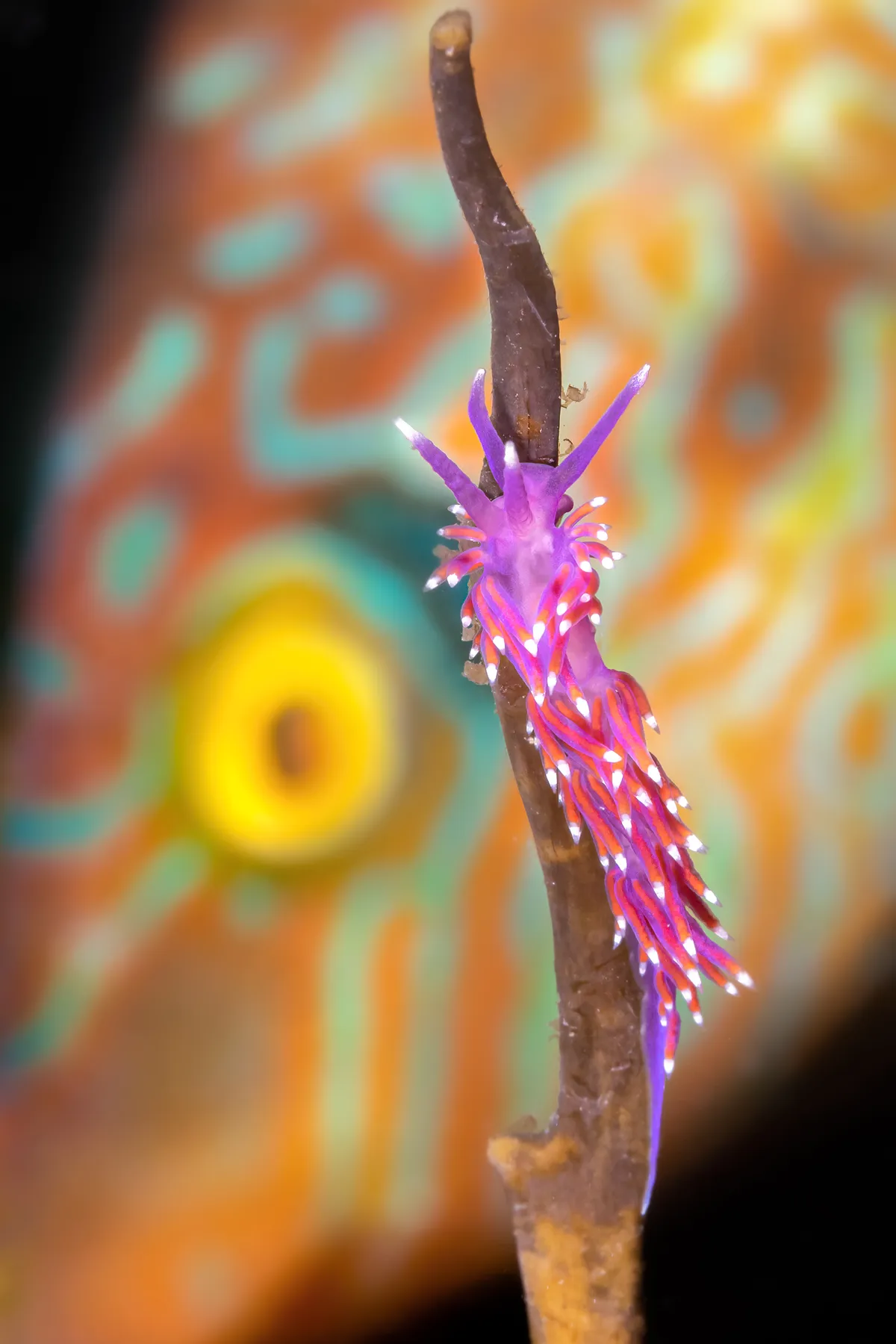
The corkwing wrasse you can see in the background was actually busy building a nest under the pier. This means he was very distracted by his duties and would regularly come back to the same spot to add more gathered pieces of seaweed.
The nudibranch had been making its way along a near-by piece of kelp, and I only had to wait for a minute or two before it made its way up a seaweed stump enabling me to grab a few shots just at the moment when wrasse and nudibranch were both in frame.
British Waters Living Together category
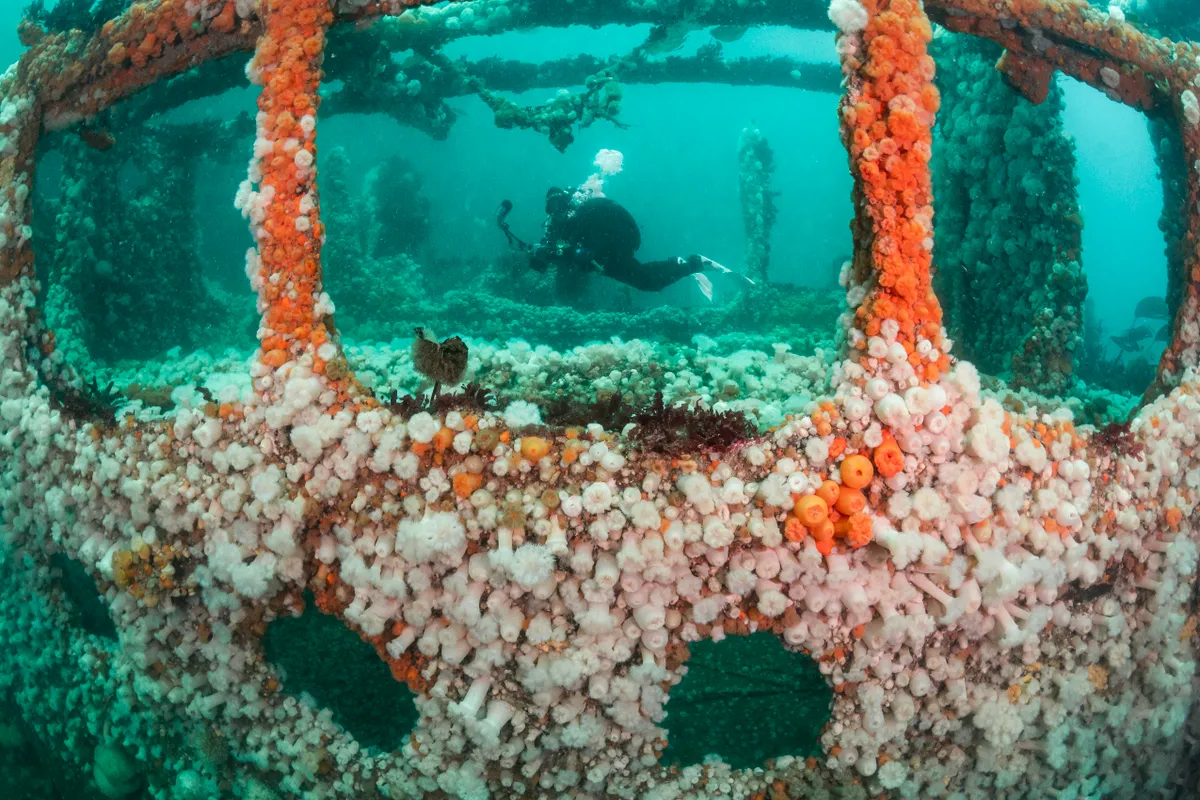
The UK, in my view, has some of the finest wreck diving in the world, and the SS Hispania in the Sound of Mull is one of my favourites. This wreck truly has become an artificial reef: the wreck attracts the wildlife and both wreck and wildlife attract the divers. Every inch of metal is covered in anemones, seaweeds or sponges, orange and white. My buddy was investigating the superstructure above a row of portholes and I moved back, shooting as wide as I could to try to give a sense of scale within this colourful scene.
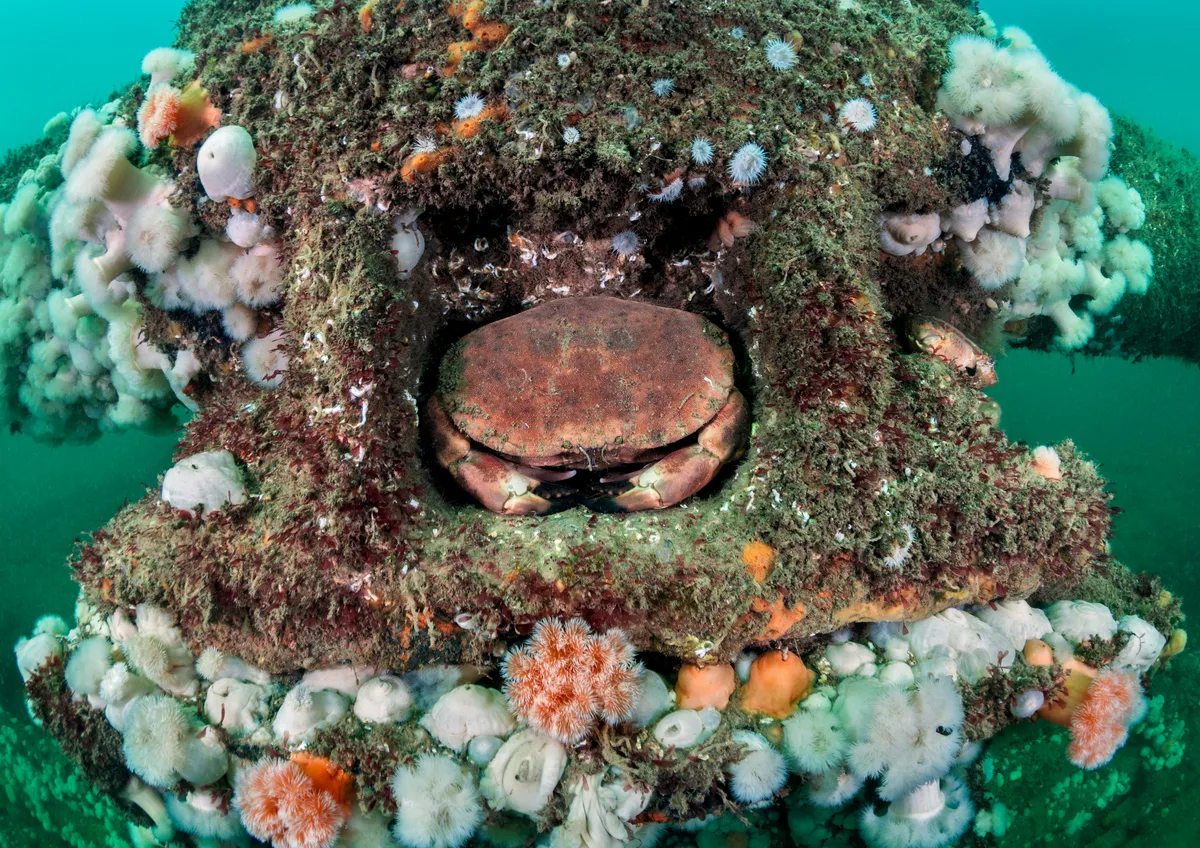
During a dive on the SS Rosalie, a wreck off the coast of Weybourne in England, I noticed these two brown crabs (Cancer pagurus) occupying a groove in one of the supporting elements of the propeller shaft. They have probably completed an important part of their life cycle – the mating, and the male on the top was protecting the female underneath until her exoskeleton hardens. I was pleased to witness and capture this special behaviour using my wide-angle lens, which allowed me to include part of the surrounding environment as well.
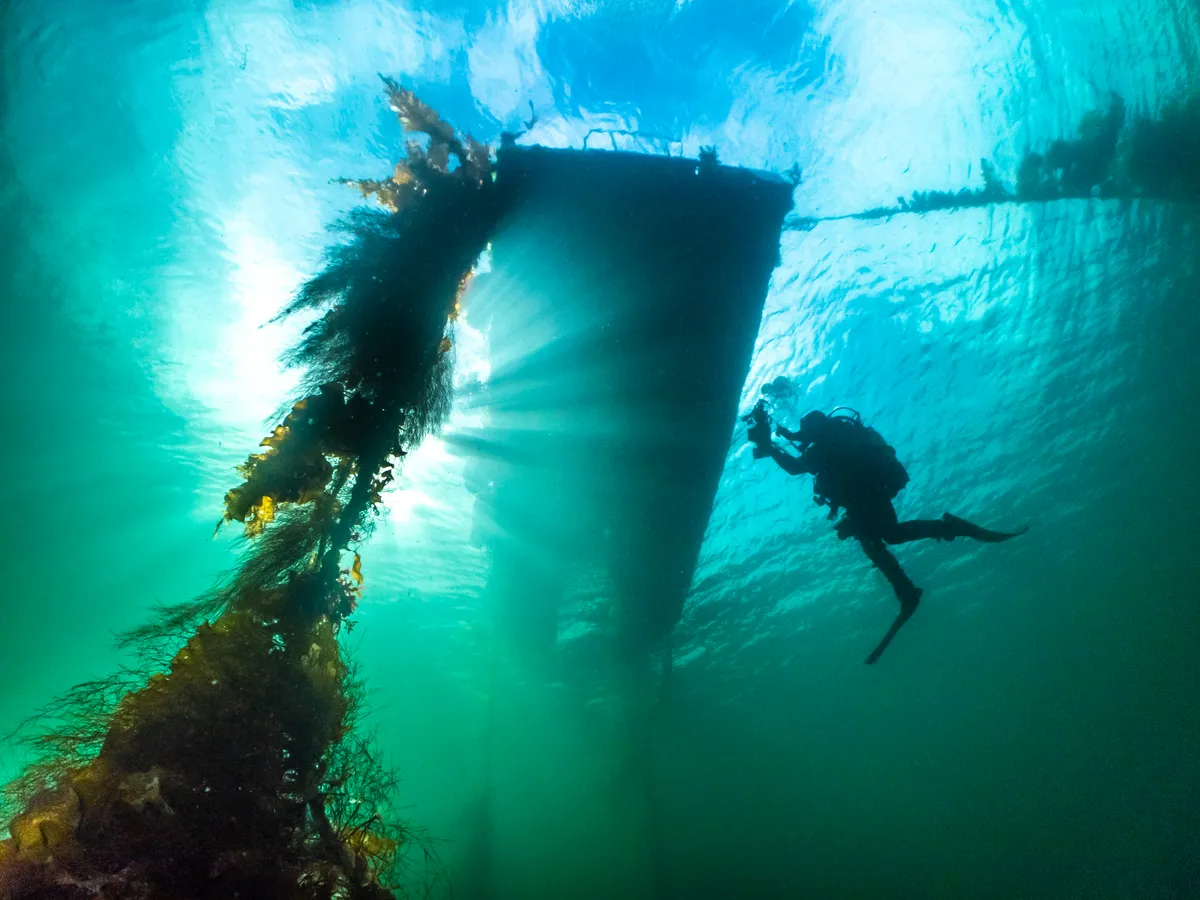
Anchored in a sheltered inlet on Loch Carron, western Scotland, this floating pontoon is used by local fishermen to stow their gear when not being used. It’s been there for some years and is now a floating island of life. The anchor lined are vertical forest of seaweeds, ascidians ad fan worms, while the underside of covered with anemones and sponges. This was a very lucky shot, as it was taken during the only 15 minute period when the sun came out on a 7 day trip!
British Waters Compact category
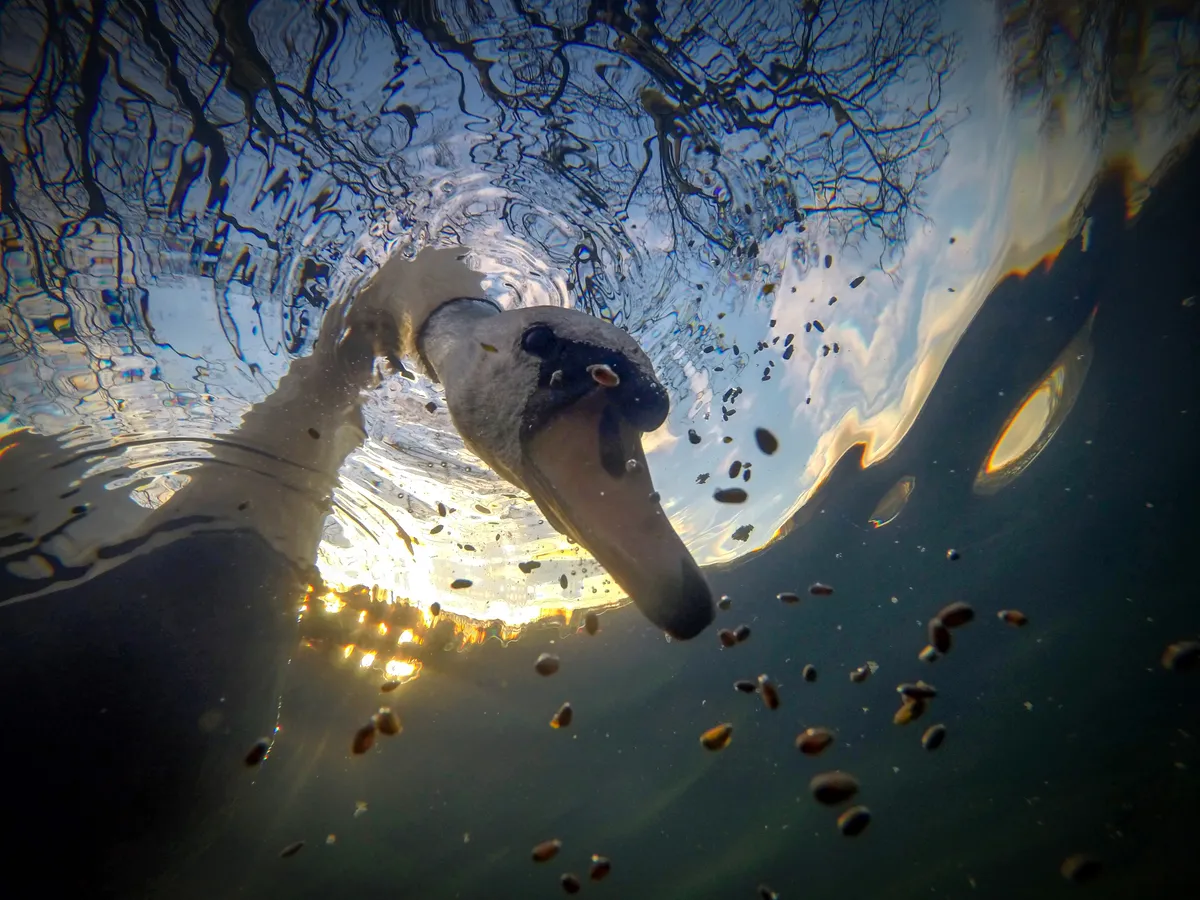
I had been watching a couple of mute swans at my local lake. They seemed to be following people around looking for food. I decided to attach a small weight to the back of my GoPro and threw it into the lake a short distance from me. The small weight would mean the GoPro always fell on its back, so I could shoot at an almost vertical angle. I have connected the GoPro to my Phone so I could remotely fire off images.
The GoPro hitting the water had attached the swan's interest and they swam over. I waited until one of the swans was in the correct position and with its head underwater and shot a high-speed burst of images enabling me to capture this picture.

Within my underwater photography I am always excited by the tiny and overlooked, mostly focusing on macro and getting as close as I can to my subject. On this day last summer the conditions were perfect, calm sea, clear viz and fantastic underwater scenery meant it was like diving through a spectacular underwater meadow. There were so many tiny stalked jellyfish clinging to the bootlace weed.
The ambient light was stunning, sunshine beaming through the long strands of bootlace. For this shot I went much wider than normal and used the ambient light to almost silhouette the tiny stalked jellyfish, emphasising its tiny shape against the naturally lit background.
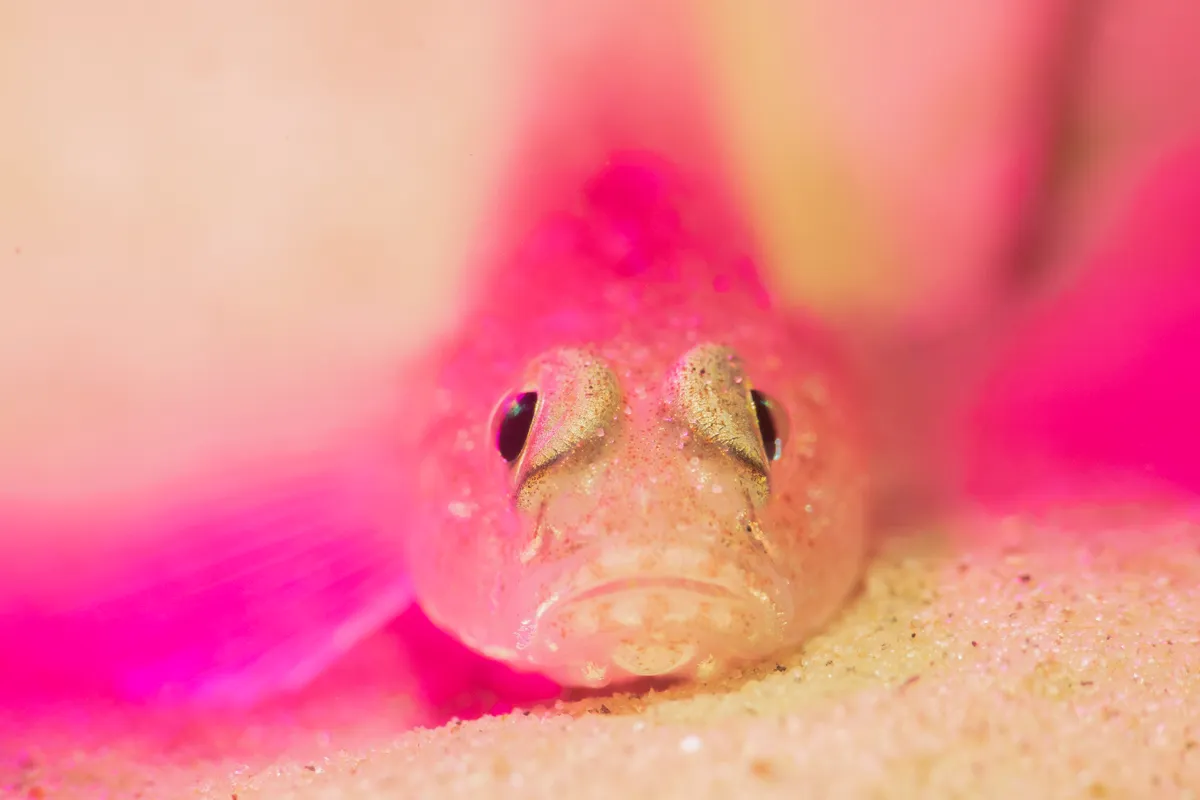
I absolutely adore these little gobies and their grumpy faces. I often watch them when I dive as they have such an inquisitive nature and often challenge me to a staring contest in which they win. They tend to blend in with their background on the sand and I wanted to make the goby stand out so for this shot I lit it with both a coloured filter behind and a snooted strobe in front to bring out the face and draw attention to an overlooked little fish. I was excited by the contrast of the vibrant pink to the glumness of the face.
Marine Conservation category
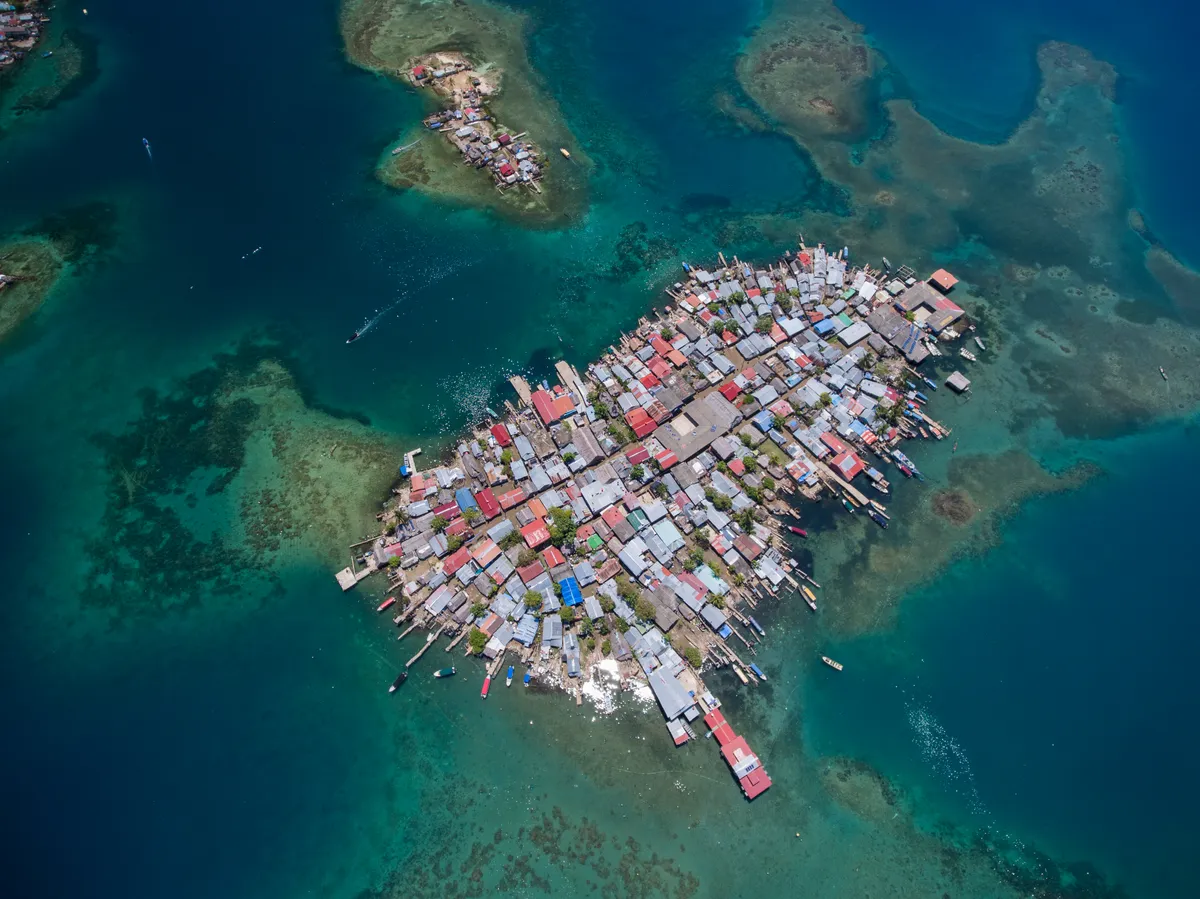
A tightly inhabited village off the coast of Panama in Guna Yala region serves as a microcosm reminder of how humans across the planet are consuming land and space at a rapid rate. Most of the Guna people live on these densely populated islands, catching fish and farming coconuts on nearby islands. The importance of human's relationship with nature and the need to protect it is becomes very apparent when you look at our species from a bird’s eye perspective and see how much space we take up.
I had come to this region of Panama to photographing the art of making mola, the traditional clothing that the Guna people wear. While waiting on a boat I flew my drone over this island to get this aerial perspective and give more impact to the image than I could have shooting at sea level or from underwater.
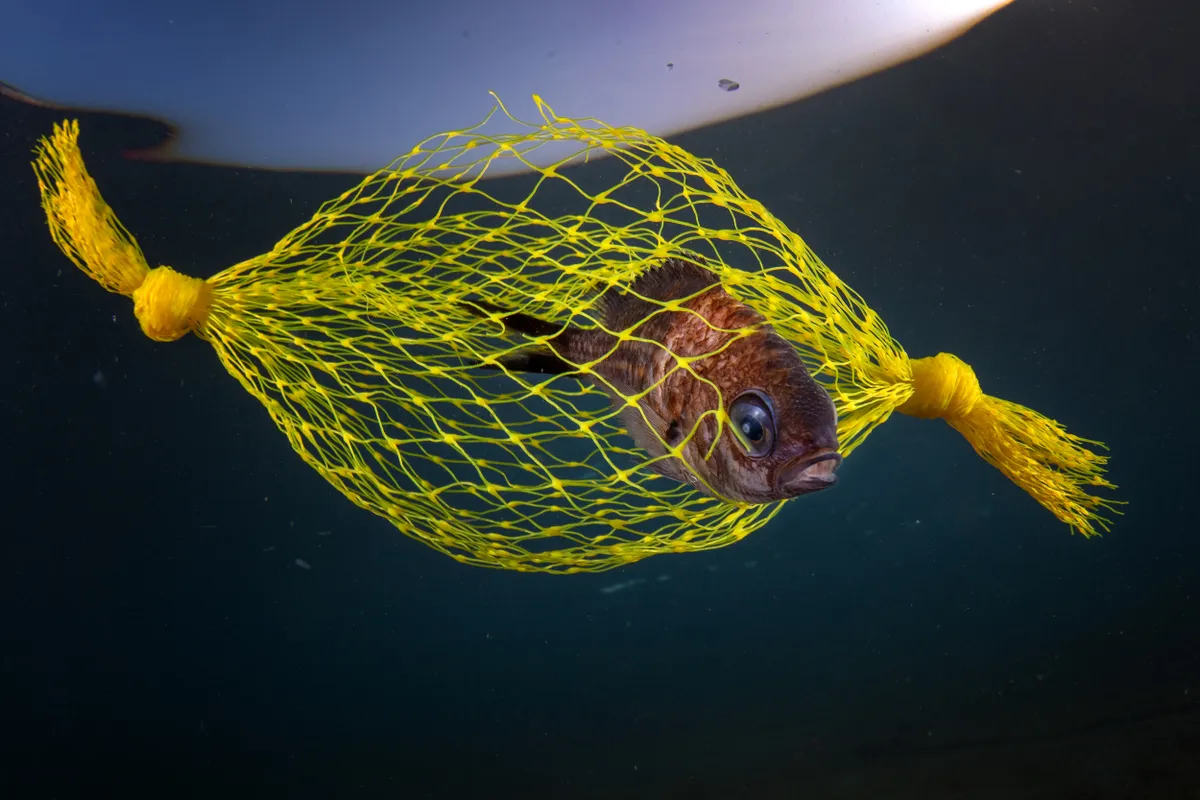
During one of my trips to the sea, I noticed a strong presence of these yellow nets closed like "candy". I could not understand their purpose. In the following days, with the help of some local fishermen, I discovered that the candy is the heart of a trap. It is filled with dead fish and inserted into another net.
Thanks to the smell of the remains of dead fish, it attracts some small molluscs - to be precise Nassarius mutabilis - that once they enter the trap they are unable to get out. Once the contents of the trap have been recovered, the candy is often abandoned in the sea, causing plastic pollution and, as visible in the shot, a trap for other organisms.

Seeing a dead animal is always sad. But seeing a big mammal dead like this sperm whale, it is something indescribable. From land the image was terrifying. But when I flew the drone the situation was even more shocking and dramatic. There was an incredibly large river of blood, maybe longer than a mile, coming out of the sperm whale.
My Backyard category
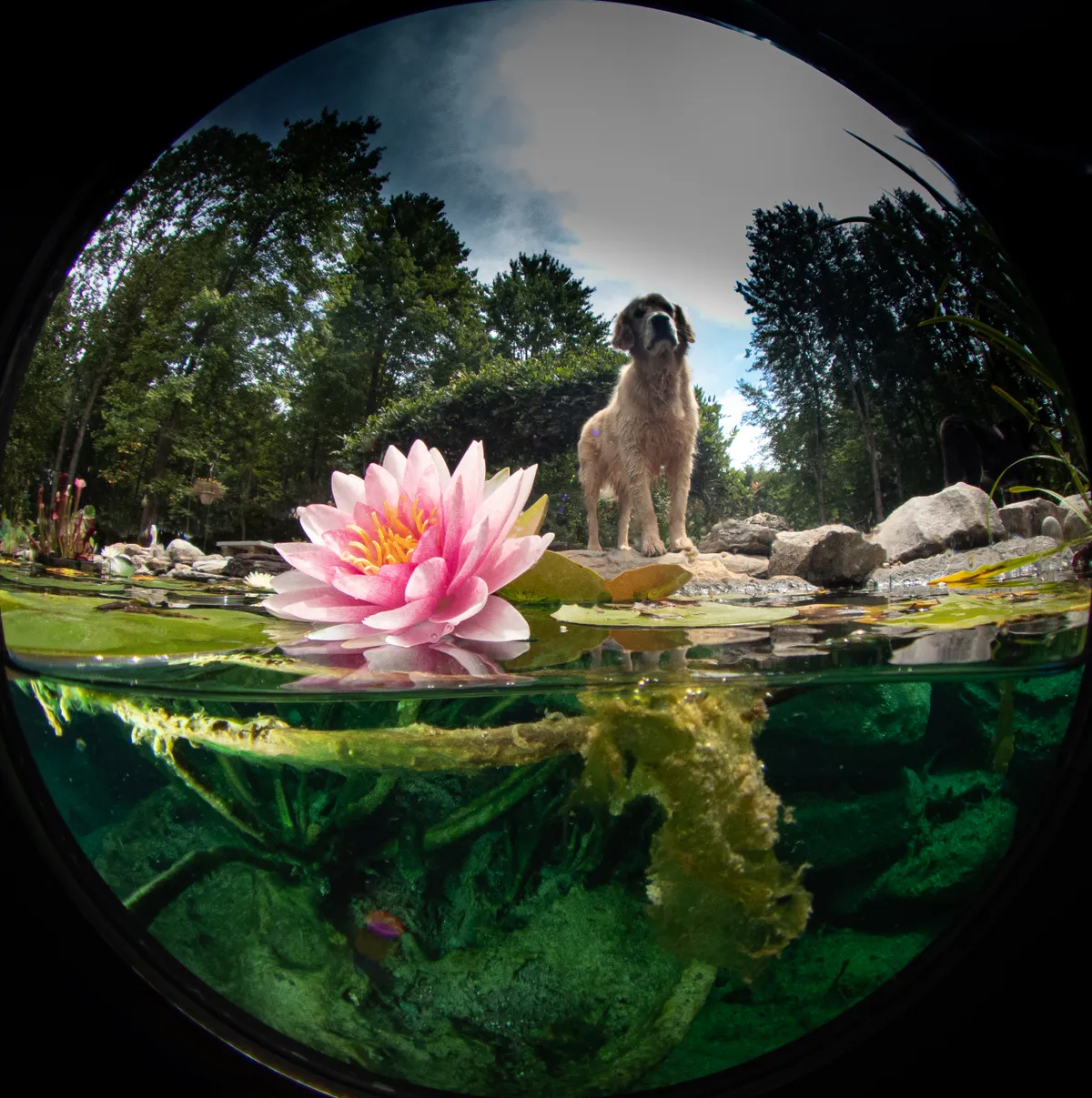
Fisheye lenses with circular frames have always fascinated me, and when Olympus made a small one for the TG-6, I was anxious to test it. This image was actually part of the research and development of a dome port constructed to make shooting over/unders easier. The port is made from a 6 inch dome that allows you to see the water line more precisely, and the image I created was to be a still life that could be reproduced consistently with any camera and lens combination for comparison. I floated in a belly boat that anglers use so that I could sight over the housing to see where the water line was. The golden retriever – Butters – is always happy to photo bomb any image in the pool.
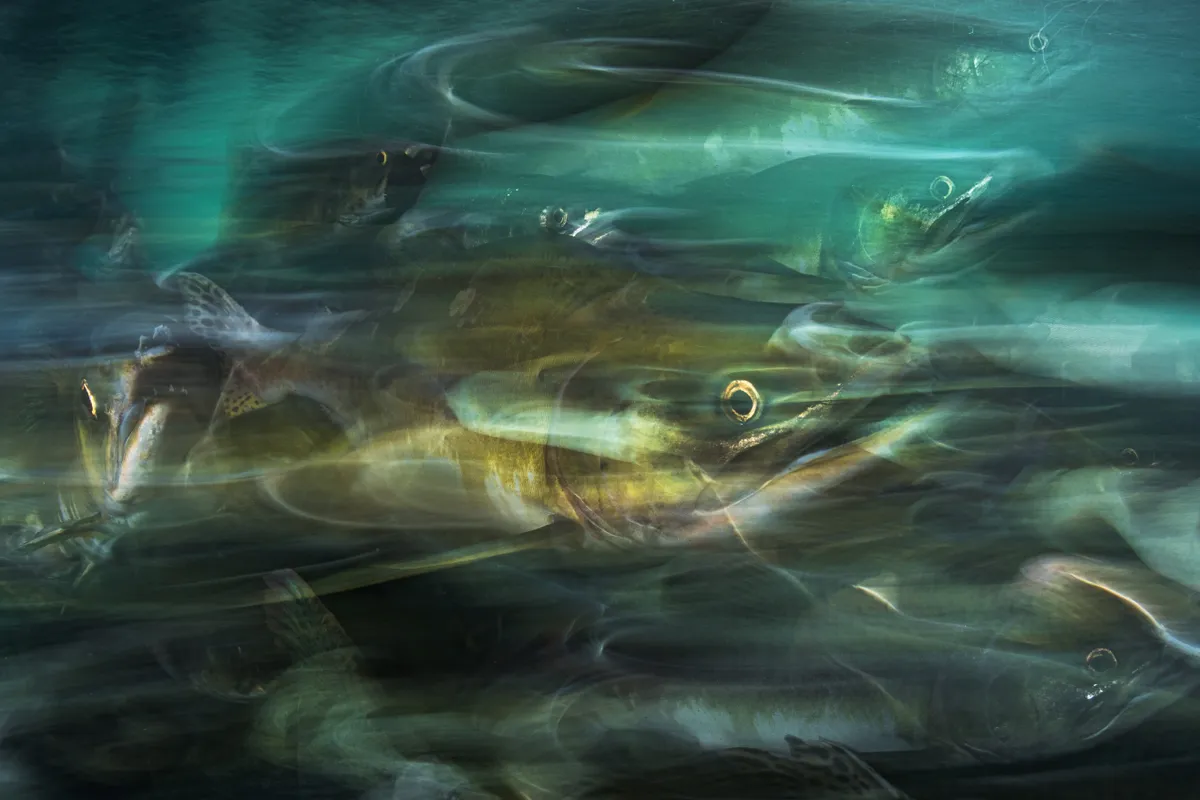
I had an abstract "fill the frame with fish faces" image in mind. I sat in one spot in the chilly, flowing river waiting for the fish to change their opinion of me from bear to rock. It actually didn't take that long. Then I kept waiting for the sun to go behind a cloud so it was dark enough to use a really slow shutter speed and wiggle the camera around until something looked pleasing. It was a ton of fun and hopefully if the salmon come back next year I can get an even better frame!
